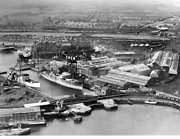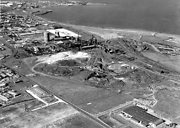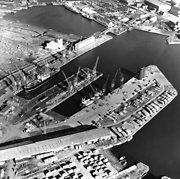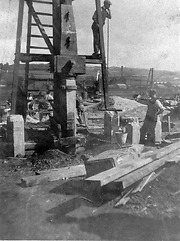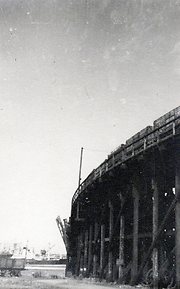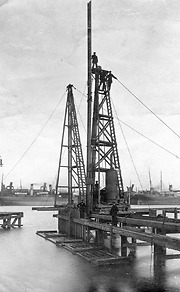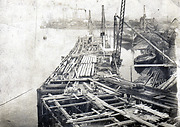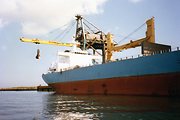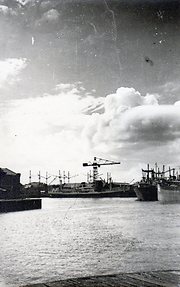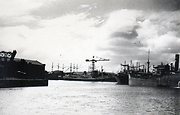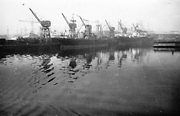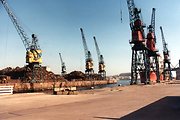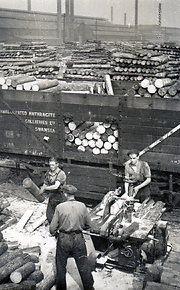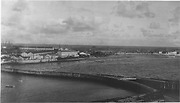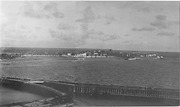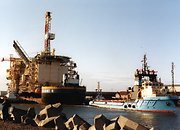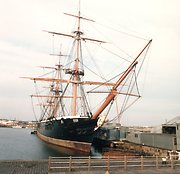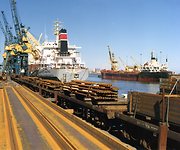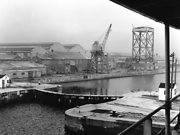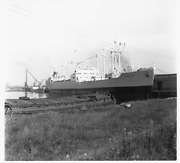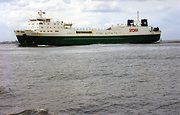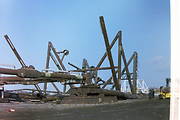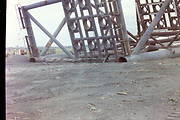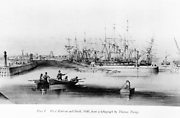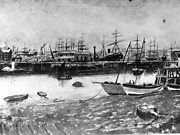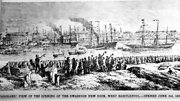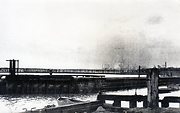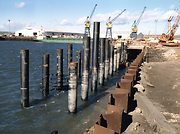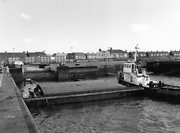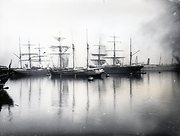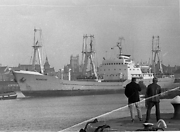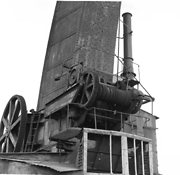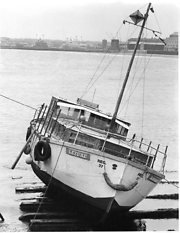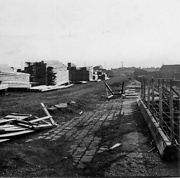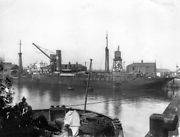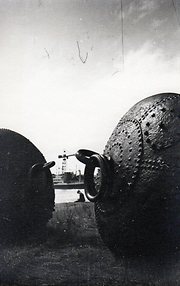 Hartlepool Sports & Leisure
Hartlepool Sports & Leisure
- Cinemas, Theatres & Dance Halls
- Musicians & Bands
- At the Seaside
- Parks & Gardens
- Caravans & Camping
- Sport
 Hartlepool Transport
Hartlepool Transport
- Airfields & Aircraft
- Railways
- Buses & Commercial Vehicles
- Cars & Motorbikes
- The Ferry
- Horse drawn vehicles
 A Potted History Of Hartlepool
A Potted History Of Hartlepool
- Unidentified images
- Sources of information
- Archaeology & Ancient History
- Local Government
- Printed Notices & Papers
- Aerial Photographs
- Events, Visitors & VIPs
 Hartlepool Trade & Industry
Hartlepool Trade & Industry
- Trade Fairs
- Local businesses
- Iron & Steel
- Shops & Shopping
- Fishing industry
- Farming & Rural Landscape
- Pubs, Clubs & Hotels
 Hartlepool Health & Education
Hartlepool Health & Education
- Schools & Colleges
- Hospitals & Workhouses
- Public Health & Utilities
- Ambulance Service
- Police Services
- Fire Services
 Hartlepool People
Hartlepool People
 Hartlepool Places
Hartlepool Places
 Hartlepool at War
Hartlepool at War
 Hartlepool Ships & Shipping
Hartlepool Ships & Shipping

Around the Docks
Details about Around The Docks
This section contains various general images and information relating to Hartlepool Docks. For a more detailed history of Hartlepool Docks see Note History of the Docks at Hartlepool.
Location
Related items () :
 'C' Jetty Union Dock
'C' Jetty Union Dock
 Donated by Hartlepool Museum Service
Donated by Hartlepool Museum ServicePart of the Shipbuilding collection
Dated 1957
'C' Jetty Union Dock looking across towards Gray's shipyar buildings. Queens Rink Ballroom on right. Rolling stock with pit props in the foreground.
More detail » 6 Horse Power
6 Horse Power
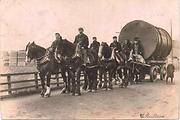 Created by L. Brittain
Donated by Les Hawksfield
Created by L. Brittain
Donated by Les HawksfieldA 6-horse team hauling what is believed to be a ship's boiler or other engine part, passing the pit-prop field, date unknown.
More detail » A 1098
A 1098
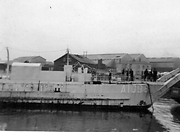 Created by unknown
Donated by Lynn Gowland
Created by unknown
Donated by Lynn GowlandThe following from the Teesside Branch of the World Ship Society: in the list of warships of the ‘Mothball Fleet’ that were laid up in the Hartlepools after WW2 there was one with the number 1098. It was a ‘Maintenance Repair Craft’ that went under the Pendant Number MRC 1098. It was in the port from around March/April 1956 until October/November 1957. If this photograph is of the same vessel, perhaps the ‘A’ prefix has been used to designate Auxiliaries? The horns on the bow would probably have been used for lifting either small vessels or buoys.
More detail » A Titanic Load
A Titanic Load
 Created by Northern Daily Mail
Donated by Northern Daily Mail
Created by Northern Daily Mail
Donated by Northern Daily MailDated 1909
An extract from the local Northern Daily Mail, Monday, 10th December, 1909.
More detail » A journey into the port half a century ago
A journey into the port half a century ago
Approaching the port
As one approached the Port from seaward the steam Pilot boat T.H. Tilly would be at anchor or patrolling in Hartlepool or Tees bay ready to supply ships with their Pilots who would be transferred from her using a small motor boat. The ship on receiving her Pilot would then enter the “Roads” called thus as it was the approach to the buoyed channel; Longscar “Bell” buoy, marking the dangers of the Longscar reef, being passed to port. As one turned to starboard into the channel No.1 “Bar” buoy, which was lit during the hours of darkness with a white light, was passed, and during daytime the clank, clank of the steam Dredger Robert de Brus with its two attendant spoil hoppers, H.P. and H.C. numbers 4 and 6 could well be heard hard at work keeping the channel clear of silt and sand. The opposite buoy to “Bar” buoy was No.2 named “Duzzy” buoy by the old Pilots, as when West Harbour entrance was open it was a middle ground buoy and they said it made them dizzy which side to pass it. A blow on the whistle might be required to get the Dredger to heave clear of the channel to let shipping pass in safety before approaching the old “Pilots” pier, built in 1473, and having passed “Spit”, No.3 buoy, inside of which was “Peggy” the old beacon pole which had been a sea mark since the 16th century. On the port side Middleton jetty, also known as the “Banjo” or stone jetty, was passed and the ship now entered the inner channel. To starboard was “Ipswich” no.5 buoy named after a pub which once stood on the Town Wall opposite.
If ships were having the assistance of Tugs, they would now have made them fast, or be making fast. The tugs could be any of the N.E.R.’s numbers 2,3,4 or 6, or the William Gray, all twin screw steam driven. On approaching the actual docks, one passed on the Middleton side the Foyboatmen’s cabin, and next to it the lifeboat house, inside which was kept the Princess Royal. Next to the lifeboat slipway was the ferry landing, with “Bull” Boagey the ferryman rowing the ferryboat between the Middleton and Hartlepool landings, mostly carrying the workmen going and coming from the Headland to the works of William Grays, “Richies” (Richardson Westgarth), or on the docks. The Hartlepool ferry landing had the lower of the two red lights on it which, when in line, led shipping into the harbour. Just beyond the Middleton landing was Withy’s dam which gave protection to Withy’s Quay (now known as Irvine’s Quay) and on which was the steam driven swan neck crane. This quay was originally where ships built locally had their engines and boilers, which were built by Richies, fitted, and was at this time mainly used to tranship machinery to other shipyards, mainly on the north east coast, although the odd ship built at the Furness yard on the River Tees was sometimes fitted out there.
The Fish Quay
On the opposite side of the harbour was the entrance to the Victoria Dock with, on the corner, the Dock Master’s office, recently demolished to make way for the Fish Quay refurbishment. This takes us nicely to the Fish Quay itself, where half a century ago you would probably see some of the Port’s steam trawlers, Friarage, Longscar, Kudos, Ben Tarbet, George D. Irvin or Loch Blair, all owned by Grahams, or seine netters among which were Sven Knud, or the 1888 built Prince Igor. You also might see a number of keelboats and cobles either landing fish or taking on supplies for the next trip, or they could be on the opposite side of the dock under the ice factory chute taking ice to keep their catches in prime condition. During the herring season “Drifters” would run into the quay, discharge their catches, and then be off again seeking the next shoal. The Fish Quay was at the south end, or to starboard, as you entered the dock, and at the other end, or to port, were the coal staithes; on the west side 17 and 18, 19 and 20 conveyors, and on the east side 25, 26, and 27 spouts. These latter were used mainly to load the smaller ships, like the small Scottish traders. Although always referred to as “puffers”, they were not the true Scottish variety who traded on the west coast; these ships took on board mainly household coal. The Port’s trawlers also bunkered here. Down the centre of the dock were two sets of mooring buoys where shipping could tie up to await their turn to load.
Entering the docks
Returning to the harbour, on the starboard side one would pass more coal loading appliances; from north to south 13, 14, 15 and 16 – these last two being where the larger ships loaded their cargoes. There were also two sets of mooring buoys in the harbour. Directly ahead as you went up the harbour was the “Old Fish Quay”, the Port’s lightening berth (now the deep water berth). Equipped with two cranes, it was used to lighten ships to a draft which enabled them to enter the inner dock system. A ninety-degree turn to port, and the entrance to the inner docks through the North Basin was ahead of you with, to port, the remains of the Middleton shipyard slipways, and the entrance to Irvine’s dry dock occasionally used by small ships for repairs to their hulls ect. Incidentally, behind the Old Fish Quay was the wide expanse of water known as the Slake, used in the early days of the Port to sluice the entrance channel and so to keep it clear of silt and sand, so maintaining the depth of the water.
North Basin and Central Dock
On entering the enclosed docks (the entrance being 70 feet in width and spanned by a swing bridge which carried both rail and road traffic) we enter the North Basin. On the port side was a set of 80-ton sheer legs also used by Richies to lift machinery ect, and with an adjacent crane to carry out repairs on ship engines. On the starboard side was the Central Marine Engine Works’ 100-ton hammerhead crane used to engine, boiler and generally fit out Gray’s new buildings, the engine works being adjacent to this quay. Proceeding through the basin via Number 3 lock, we enter Central Dock. Immediately to starboard was Gray’s number 4 dry dock and, beyond it, the slipways where many fine ships were launched. At right angles to the slips was the quay known as Slag Island (slag being used as the foundation of the quay). This was used by Gray’s as an overflow quay on which ship repairs could be carried out afloat. Behind this quay were the timber ponds on which great rafts of timber floated during their seasoning process. On the port side of Central Dock was the quay known as the “Hydraulics”, so called because it was fitted with cranes powered by hydraulic machinery. Also on this quay was the huge number 8 warehouse. At the height of the timber season, when Union Dock was full, the occasional timber ship would be discharged here.
Union Dock, Coal Dock, Jackson Dock
On leaving Central Dock, again through an opening spanned by a swing bridge carrying road traffic only, we enter Union Dock. Directly to port was a short quay with two cranes and known as “G” and “H” quay. An odd cargo of bricks was sometimes unloaded there, and as it was near to the Dock Engineer’s workshop you would see the Port’s Tugs there undergoing afloat repairs. To starboard were the three jetties of the dock where timber, iron ore, pulp ect. were handled. “A” and “C” jetties were craned with fixed-jib electric cranes, but “B” jetty was un-craned.
In the south east corner of the dock was Pearson’s Corner leading to one of the two sets of locks from which ships entered and left through the old entrance to the West Harbour, which closed in 1924 but which is today, of course, the entrance to our Marina. Ahead but slightly to port was the original dock of the West Harbour, the Coal Dock, with more staithes on its eastern side (numbers 9,10,11 and 12). There was also a large, high conveyor originally built to bunker the Furness- and Irvine-built ships and ships in ballast which had discharged in the West Docks, as well as loading the larger type of ship. At the south end of the Coal Dock was Vulcan Quay, used by Kindbergs as an afloat repair quay. Opposite the staithes was Ballast Quay, sometimes used by ships laying up. To the west of the Coal Dock was Jackson Dock. On its east side, and on the other side of Ballast Quay, was Tay Bridge coal staithes, with the quay at right angles to it having a 20-ton hydraulic crane which was used at times to load pipes. Next to this crane was No. 2 warehouse, which on the odd occasion took a cargo of grain, though it was still in use for storing a variety of commodities, though they were brought by road or rail and not by sea. The quay on the opposite side of Jackson Dock was the North Quay, sometimes used by Grays for ships which they were repairing. Across the top, west end, of Jackson Dock was Gray’s Old Yard with slipways, and the dry dock which today has H.M.S. Trincomalee completing her refurbishment in it. The quay also had a crane which Grays used for the fitting out of their ships. Today, of course, this end of the quay is the berth of the town’s Wingfield Castle, built by Grays and now refurbished and one of the tourist attractions of the Marina. At the south west corner of the dock was the entrance to Swainson Dock, alongside which was Gray’s offices. Between the Jackson dry dock and Gray’s offices was a large workshop used by Grays. It had originally been another warehouse, and on the site today is the excellent Museum of the Hartlepools. Swainson Dock entrance was also spanned by a swing bridge, known as “Racers” (probably because it took so long to move to the open position – it was very slow).
Swainson Dock
When entering Swainson Dock to port was the No. 4 warehouse, famously known as the Match Factory and which so spectacularly took fire and burnt down in 1954. Ahead was the quay behind the railway station on which and by which it was known as the “Tin Sheds”. To starboard as you came into the dock was Gray’s Swainson yard with its launch ways and a further dry dock. A ninety-degree turn to starboard past the dry dock took you into Hart Dock. In the past this dock would have been teeming with ships discharging timber.
Trade and Industry
Having completed a voyage through the dock system some notes on the trades and industry it supported might be appropriate. We have already mentioned the shipyards where Grays built many fine cargo ships and the odd tanker. They did a considerable amount of repair work and dry dock work, as well as constructing marine engines, as did Richardson Westgarth. Kindbergs and Daltons were also ship repairers on the port. The principle trade was “king” coal, mainly shipped to the south of England, but with shipments to Scotland of household and other types of coal. Export cargoes were sent to Scandinavia and Italy and the odd cargo of coke was shipped out. The import of timber was the next important commodity of the trade of the port; props for the mines, sawn wood for building construction, sleepers for the railways, skulskarp and hardwoods, pine from Canada and last but not least, timber for the Match Factory. Paper pulp was brought in for the local paper mill. Steel and iron scrap arrived for the steel works as well as large amounts of iron ore from Scandinavia and Spain. Occasionally a cargo of grain would be discharged into No. 2 warehouse and a cargo of iron or steel pipes loaded at the crane next to No. 2 warehouse. The cranes at “G” and “H” would be in use for the odd cargo of bricks arriving from Belgium. Magnesite from the Steetley works on Spion Cop was shipped using the coal spouts in the Coal Dock. Oil bunkers would arrive in small Tankers from the terminal on the River Tyne.
More detail » A steam engine and driver on the docks
A steam engine and driver on the docks
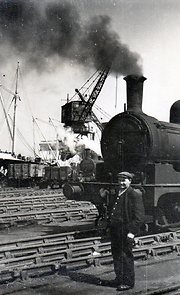 Donated by Hartlepool Library Service
Donated by Hartlepool Library ServiceA steam engine and driver on the docks with a crane unloading timber in the background.
HHT&N 280
More detail » A view over the docks
A view over the docks
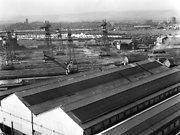 Donated by Hartlepool Library Service
Donated by Hartlepool Library ServiceA view over the docks with the gasworks on the right and St Oswald's Church on the left.
HHT&N 296
More detail »
 Admiral Crombie visiting Mothball Fleet
Admiral Crombie visiting Mothball Fleet
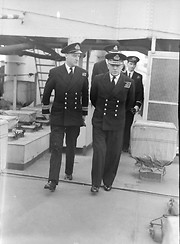 Created by NDM
Donated by Hartlepool Museum Service
Created by NDM
Donated by Hartlepool Museum ServiceAdmiral Crombie visited the Royal Navy Reserve Ships in Hartlepool Docks and is possibly here on Loch Arkaig which was the HQ vessel. This will have been circa 1954.
More detail » Aerial Photograph of West Hartlepool Dock System
Aerial Photograph of West Hartlepool Dock System
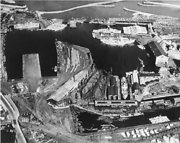 Donated by Hartlepool Museum Service
Donated by Hartlepool Museum ServicePart of the Shipbuilding collection
Aerial Photograph of West Hartlepool Dock System showing Gray's North yard in the foreground and remnants of the mothball fleet in the background.
More detail » Aerial View of Hartlepool Town area
Aerial View of Hartlepool Town area
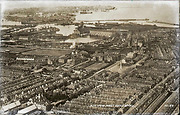 Donated by Hartlepool Library Service
Donated by Hartlepool Library ServiceAerial View of Hartlepool Town area before the Civic Centre was built. It also show a lot of the dock area.
HHT+N 483
More detail » Aerial View of the Docks (1)
Aerial View of the Docks (1)
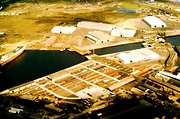 Donated by Mr. John Brooker
Donated by Mr. John BrookerAerial View Hartlepool Docks, showing Central Dock (left), North Basin (centre), Victoria Dock (right). and the area known as “The Slake” in the background. Cargo Storage sheds, and a vehicle import storage area are in the foreground.
More detail » Aerial View of the Docks (2)
Aerial View of the Docks (2)
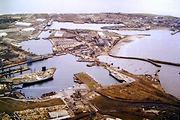 Donated by Mr. John Brooker
Donated by Mr. John BrookerAerial view of the West Harbour area, with May & Hassle, Timber Importers middle foreground. The Ship Egton is tied up on 'A' Jetty, Union Dock. To the right is the Coal Dock, with HMS Warrior undergoing restoration, with Union Dock, Central Dock, North Basin, and Victoria Dock.
More detail » Aerial view of West Hartlepool Docks
Aerial view of West Hartlepool Docks
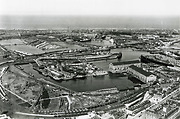 Donated by Hartlepool Library Service
Donated by Hartlepool Library ServiceAerial view of Hartlepool Docks. Not know when picture was taken but there is a steam train at the bottom of the picture.
HHT&N 480
More detail » Aerial view of the docks
Aerial view of the docks
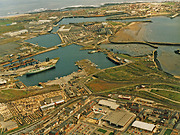 Donated by Hartlepool Library Service
Donated by Hartlepool Library ServiceAerial view of the docks. St Hilda's Church can be made out in the top right hand corner and Church Street bottom left.
HHT+N 718
More detail » Alpherat at CMEW
Alpherat at CMEW
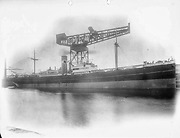 Part of the Hartlepool Library Services collection
Part of the Hartlepool Library Services collectionMV Alpherat at CMEW Dock
More detail » An empty Victoria Dock
An empty Victoria Dock
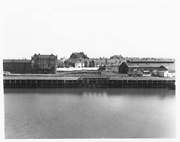 Donated by Douglas Ferriday
Donated by Douglas FerridayPart of the Hartlepool Library Service collection
Picture from 1965 with no shipping in Victoria Dock.
More detail » Arrivals and Sailings
Arrivals and Sailings
Snippets of information relating to various ship arrivals and sailings from the Hartlepools, mostly taken from local newspapers:
October, 1955: A timber cargo was discharged at Hartlepool by the 4-masted Swedish cadet ship Albatross. The vessel later sailed for Newcastle for a cargo of coal.
More detail » Ballast Quay
Ballast Quay
 Created by Francis Elsdon
Donated by Hartlepool Museum Service
Created by Francis Elsdon
Donated by Hartlepool Museum ServicePart of the Elsdon Collection collection
Dated 1989
Ballast Quay, Hartlepool Docks. Small vessels out of the water on the quay.
More detail » Blumer's shipyard c1858
Blumer's shipyard c1858
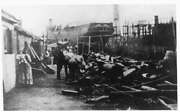 Part of the Hartlepool Library Services collection
Part of the Hartlepool Library Services collectionBlumer's shipyard c1858. Luke Blumer keeping an eye on his workmen. I wonder why a woman and child are in the picture.
More detail » Boats out of the water
Boats out of the water
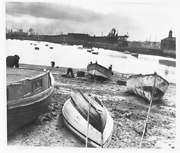 Donated by Douglas Ferriday
Donated by Douglas FerridayPart of the Hartlepool Library Service collection
Boats out of the water in West Harbour. You can see the Dockmasters office in the picture.
More detail » Boiler being lifted by CMEW Crane
Boiler being lifted by CMEW Crane
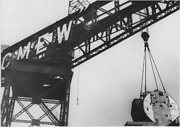 Donated by Hartlepool Museum Service
Donated by Hartlepool Museum ServiceBoiler being lifted by CMEW Crane.
More detail » Boilers on Dockside
Boilers on Dockside
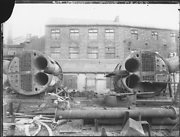 Donated by Hartlepool Museum Service
Donated by Hartlepool Museum ServiceTwo boilers on the dockside. The image is from a glass plate negative.
More detail » Braaland and Jane in Dock
Braaland and Jane in Dock
 Donated by Hartlepool Museum Service
Donated by Hartlepool Museum ServiceA group of seven men pose on the dockside in front of the Norwegian ship Braaland. A ship called Jane on the right.
HHT&N 270
More detail » Building in scaffolding near Jackson Dock
Building in scaffolding near Jackson Dock
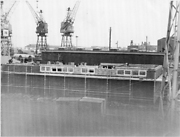 Donated by Hartlepool Museum Service
Donated by Hartlepool Museum ServiceBuilding in scaffolding near Jackson Dock.
More detail » CMEW Crane
CMEW Crane
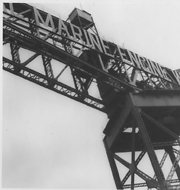 Created by Bill Boagey
Donated by Hartlepool Museum Service
Created by Bill Boagey
Donated by Hartlepool Museum ServicePart of the Bill Boagey collection
CMEW Crane.
More detail » CMEW Crane
CMEW Crane
 Donated by Hartlepool Museum Service
Donated by Hartlepool Museum ServiceCMEW Crane with the works in the background.
More detail » Central Dock Hartlepool
Central Dock Hartlepool
 Donated by Mike Oxley
Donated by Mike OxleyCentral Dock, Hartlepool taken from a postcard around 100 years old
More detail » Central Dock Hartlepool
Central Dock Hartlepool
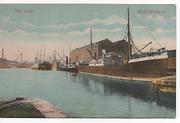 Donated by Mike Oxley
Donated by Mike OxleyCentral Dock, Hartlepool taken from a postcard around 100 years old
More detail » Central Marine Engineering Works c1885
Central Marine Engineering Works c1885
 Donated by Hartlepool Museum Service
Donated by Hartlepool Museum ServiceCentral Marine Engineering Works c1885
More detail » Church Street and Hartlepool Docks
Church Street and Hartlepool Docks
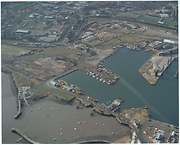 Donated by Hartlepool Library Service
Donated by Hartlepool Library ServiceChurch Street and Hartlepool Docks from the air. Before the docks were transformed into the Marina we have today.
More detail » Church Street and Hartlepool Docks (2)
Church Street and Hartlepool Docks (2)
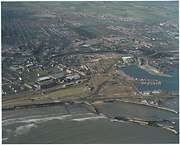 Donated by Hartlepool Library Service
Donated by Hartlepool Library ServiceAnother view of Church Street and Hartlepool Docks before the Marina development.
More detail » Civil engineering work near the Wood Quay
Civil engineering work near the Wood Quay
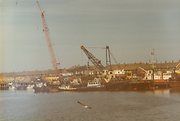 Created by Francis Elsdon
Donated by Hartlepool Museum Service
Created by Francis Elsdon
Donated by Hartlepool Museum ServicePart of the Elsdon Collection collection
Civil engineering work near the Wood Quay, Hartlepool Docks.
More detail » Coal Dock
Coal Dock
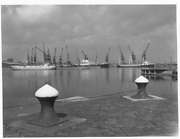 Donated by Douglas Ferriday
Donated by Douglas FerridayPart of the Hartlepool Library Service collection
View across the Coal Dock taken in 1963. Sixteen cranes working.
More detail » Coal Staithes
Coal Staithes
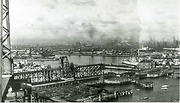 Donated by Hartlepool Library Service
Donated by Hartlepool Library ServiceA view of the Coal Staithes. The mothball fleet in the dock. Image taken from the NBC Rigg, which was built in the basin. The swing bridge can be seen to the right.
HHT&N788
More detail » Coal Staithes
Coal Staithes
 Created by NDM
Donated by Hartlepool Museum Service
Created by NDM
Donated by Hartlepool Museum ServiceProbably the Coal Staithes in the Old Harbour. In the background looks to be the construction of the Deep Water Berth.
The funnel with H on it is a ship from the Hudson steamship Company, a white H on a red band and a dark blue funnel. It is possibly Hudson Cape.
More detail » Coal tower
Coal tower
 Created by Joseph Tombling
Donated by Katrina Harper
Created by Joseph Tombling
Donated by Katrina HarperDated 1958
Taken in the docks about 1958 with the photographer's two daughters in the foreground.
More detail » Colliers in Victoria Dock
Colliers in Victoria Dock
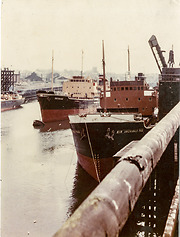 Donated by Hartlepool Museum Service
Donated by Hartlepool Museum ServiceColliers in Victoria Dock. Sir Archibald Page & Southwark.
More detail » Colliers in Victoria Dock
Colliers in Victoria Dock
 Donated by Hartlepool Museum Service
Donated by Hartlepool Museum ServiceColliers in Victoria Dock. Sir Archibald Page, Southwark, Wandsworth & Kingston
More detail » Construction of the docks at Middleton
Construction of the docks at Middleton
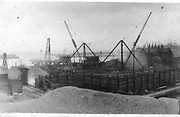 Donated by Hartlepool Library Service
Donated by Hartlepool Library ServiceA lot of work going on constructing the docks at Middleton. The Dockmasters office can be seen on the right.
HHT&N 300
More detail » Cottages at Dockside
Cottages at Dockside
 Donated by Hartlepool Museum Service
Donated by Hartlepool Museum ServicePart of the David Wise collection
An early (probably 19th century) view of activity at the dockside. It appears that demolition is taking place around a row of two or three cottages.
More detail » Cranes and shipping
Cranes and shipping
 Donated by Hartlepool Library Service
Donated by Hartlepool Library ServiceCranes and shipping at the docks. The Adelfi Star and the Kinsale can be seen in the picture.
HHT&N 294
More detail » Cranes at Union Dock
Cranes at Union Dock
 Donated by Douglas Ferriday
Donated by Douglas FerridayPart of the Hartlepool Library Services collection
Dated 1920
Cranes at Union Dock unload cargo from ships into waiting railway trucks. Circa 1920.
HHT+N 780
More detail » Cycling tour of Norway
Cycling tour of Norway
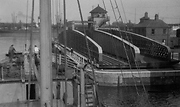 Created by Joseph Tombling
Donated by Mrs. Katrina Harper
Created by Joseph Tombling
Donated by Mrs. Katrina HarperDated 1938
Joseph Tombling and a friend setting out for a cycling tour of Norway in 1938. They are on board the small Norwegian steamer Gol, bound for Bergen, which is just passing the swing bridge as it enters the North Basin.
More detail » Dentons Shipyard c1860
Dentons Shipyard c1860
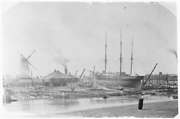 Part of the Hartlepool Library Services collection
Part of the Hartlepool Library Services collectionNice picture of Denton's Shipyard from around 1860. First time I can recall seeing a windmill on the docks.
More detail » Dentons Shipyard c1860 (2)
Dentons Shipyard c1860 (2)
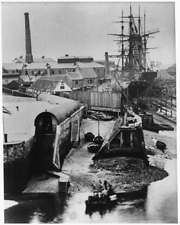 Part of the Hartlepool Library Services collection
Part of the Hartlepool Library Services collectionA detailed picture with a sailing ship being built/repaired. Middleton ferry in the foreground.
More detail » Dignitaries on a steam tug
Dignitaries on a steam tug
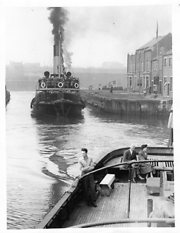 Donated by Hartlepool Library Service
Donated by Hartlepool Library ServiceA group of dignitaries on a steam tug coming into Hartlepool harbour. There is bunting on the dockside.
HHT&N 298
More detail » Dock Accidents and Incidents
Dock Accidents and Incidents
Various accounts, mainly drawn from local newspapers, of accidents and incidents in and around the docks:
Hartlepool Northern Daily Mail, Thursday, November 13th, 1879:
SHIP'S OFFICER DROWNED AT HARTLEPOOL. A melancholy occurrence was disclosed at Hartlepool at ten o'clock this morning, when the lifeless body of Daniel Clark was recovered from the Victoria Dock. The deceased was mate of the Yarmouth ship William, and was seen alive for the last time about three o'clock yesterday afternoon, when he was engaged with a chisel on a temporary scaffolding which had been thrown over the ship's side. There is, as yet, no evidence as to how he got into the water; but from what is known of the deceased, and of the circumstances under which he was last seen, there is too much reason to fear that he was the victim of an accident. He was, of course, shortly afterwards missed; and as tidings of him could be gleaned, the dock was dragged, with the result that the body was found as stated. He was 40 years of age, belonged to Yarmouth, and had a wife and family there.
The name of the captain is William Mobbs. Several vessels in the harbour have hung their colours half-mast in token of the melancholy event. His friends have been communicated with, and an inquiry will be held by the Coroner to-morrow.
Hartlepool Northern Daily Mail, Tuesday, December 16th, 1879:
DROWNED IN WEST HARTLEPOOL DOCKS. A man was drowned in the Swainson dock on Saturday evening. His name was Michael Welsh, and on that evening he had borrowed a cart from the Commercial Hotel for the purpose of taking some luggage to the steamer Hecla, which was lying at the No. 4 warehouse quay. Someone on board heard the fall into the water, and a rope was lowered, but deceased was either stunned by the fall, or paralysed by the cold, for he made no apparent effort save himself. The North-Eastern police dragged for several hours, but without success; and again on Sunday morning, when search for the body was again abandoned, it being the opinion that the corpse had drifted under the steamer, or changed its position by the action of the pump to supply Messrs Gray's graving dock. Endeavours were still proceeding to-day to recover the body, but up to four p.m. without success.
Hartlepool Northern Daily Mail, Monday, January 9th, 1888:
BOY SUFFOCATED AT WEST HARTLEPOOL. A sad occurrence took place on board the barque Khedive, lying in the dock at West Hartlepool, near the police station, about half past four o'clock on Saturday afternoon, by which an apprentice named Robert Bedlington (17), who resided with his widowed mother at 9, Johnson Street, lost his life.
The vessel has been laid-up at West Hartlepool for about three months and was about to go to sea, and the boatswain, Denson, sent deceased to stove the bread tank – a place about 4ft. square—with charcoal, the reason being that the tank was wet. The boy was instructed to put the charcoal down by means of a pail to dry it. A short time after he was missed; search was made for him, and he was found in the tank quite dead, supposed to have been suffocated by the fumes from the charcoal.
Another apprentice named Frederick Arrowsmith, of Shildon, who went to assist deceased, had a very narrow escape. He went into the tank to try and lift him, but before he got him properly out he also was affected by the fumes, and had to pulled out by a fork. He was discovered by Richard Pounder, another apprentice. The lad who has lost his life was the only surviving child of his mother. She has had a family of nine, and two of her children, together with their father, died during last year, the father being lost at sea.
Northern Daiy Mail on Monday, October 27th, 1919:
A Rescue at the Docks.
"Elderly Ship Captain's Gallant Act. An exceedingly plucky act on the part of an elderly ship captain was witnessed on the docks shortly before 5 o'clock last evening.
Three or four boys were playing by the side of the Coal Dock, near what is known as the Tay Bridge, when one of them - aged about ten years - fell into the water. Captain Soren Corneliussen, of the Norwegian barque Nicolay H. Knudsen, who was walking along the quayside about 25 yards away, at once ran to the spot, and, divesting himself of his overcoat, scrambled down some steps that were near at hand and swam to the boy, who was some distance off.
The lad seized him immediately he approached him, and it was only with great difficulty that Capt. Corneliussen broke his hold and then swam back with him to the steps. Here he was assisted by Dr. Pearson and William Fletcher, horsekeeper for the N.E.R., who had in the meantime come on the scene, and the boy was taken to Fletcher's house, which is on the docks. Dr. Pearson then accompanied the captain back to his ship.
It may be mentioned that Captain Corneliussen is turned 67 years of age. The name and address of the boy whom he so gallantly rescued was not obtained, and the West Hartlepool Police would be glad of this information."
 Dock Board Office Outing by numbers
Dock Board Office Outing by numbers
 Created by unknown
Donated by Frances Wilson
Created by unknown
Donated by Frances WilsonA Dock Board Office outing to Scarborough with numbers attached to aid identification - if you can identify any of the missing names, please let us know.
More detail » Dock Master and Custom Offices
Dock Master and Custom Offices
 Donated by Douglas Ferriday
Donated by Douglas FerridayPart of the Hartlepool Library Service collection
Dated 1977
The Dock Master's and Customs Offices, also known as the Customs Boarding Station, were located near the lock gates at Jackson Dock. This photograph was taken in 1977. The building, which still stands, is now part of the Marina complex.
More detail » Dockland
Dockland
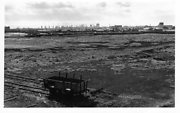 Donated by Hartlepool Library Service
Donated by Hartlepool Library ServiceSite of some of the old prop field empty in this picture. You can see the main dock cranes, as well as the CMEW crane in the background.
HHT&N 304
More detail » Docks Panorama
Docks Panorama
 Created by Don Stephenson
Donated by Hartlepool Library Service
Created by Don Stephenson
Donated by Hartlepool Library ServicePanorama of Hartlepool docks stitched together from three old pictures which themselves had been put together out of other pictures. They were a mess but, with a bit of time and effort, they have been restored to produce this.
More detail » Docks Panorama views
Docks Panorama views
Three views of the docks which can be seen stitched together as 'Dock Panorama'.
More detail » Docks Road
Docks Road
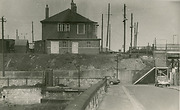 Donated by Hartlepool Museum Service
Donated by Hartlepool Museum ServiceTaken looking northeast on the road which was open to the public through the docks. Probably late 1960s. Over the railway line is Millbank Crescent.
More detail » Docks Road Installation
Docks Road Installation
 Donated by Hartlepool Library Service
Donated by Hartlepool Library ServiceInstalling a road through the docks.
More detail » Docks looking towards Middleton Road
Docks looking towards Middleton Road
 Created by Doris Wilson
Donated by the family of the late Doris Wilson
Created by Doris Wilson
Donated by the family of the late Doris WilsonThe photo was taken in the mid 1960s and shows the Nitrovic building and silos on Middleton Road, a view which would now be obscured from this angle by the large office buildings in Middleton Road. The Middleton Road swing bridge can clearly be seen across the dock.
On the left, a pile of timber can be seen on the Ballast Quay and this is where the Premier Inn and Old West Quay pub now stand.
More detail » Dockside View
Dockside View
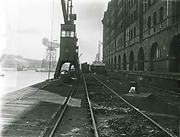 Donated by Hartlepool Library Service
Donated by Hartlepool Library ServiceLarge warehouse on right of image, CMEW (Central Marine Engine Works) in the background. Timber in wagons.
HHT&N795
More detail » Electric coal conveyor
Electric coal conveyor
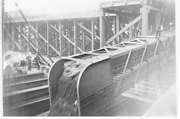 Part of the Hartlepool Library Services collection
Part of the Hartlepool Library Services collectionElectric coal conveyor taking coal from the rail wagons to the ships at Hartlepool Docks
More detail » Elsie - SH 280 (1)
Elsie - SH 280 (1)
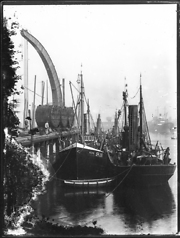 Created by unknown
Donated by Hartlepool Library Service
Created by unknown
Donated by Hartlepool Library ServiceThe steam trawler Elsie and four others alongside Irvine's Quay - probably to have new boilers fitted. The Elsie was bought by James Pattison of West Hartlepool, in 1928 and then sold in 1934 to the Stanley Steam Fishing Co Ltd, Fleetwood. More information on this vessel can be found at http://www.fleetwood-trawlers.info
HHT&N 787
More detail » Fishing Boats in Victoria Dock (2)
Fishing Boats in Victoria Dock (2)
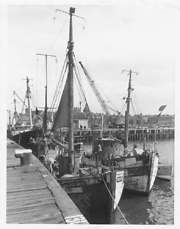 Donated by Douglas Ferriday
Donated by Douglas FerridayPart of the Hartlepool Library Service collection
Moored fishing boats including The Prince Igor
More detail » Fishing boats in the docks
Fishing boats in the docks
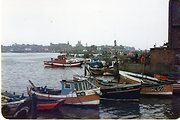 Donated by Mrs. Ann Stanbridge
Donated by Mrs. Ann StanbridgeLocal fishing boats clustered together in the docks prior to the building of the new Marina.
More detail » Flattening the coal
Flattening the coal
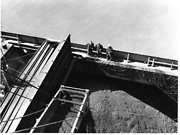 Donated by Hartlepool Library Service
Donated by Hartlepool Library ServiceTaken in May 1963, this picture shows a ship loaded with coal. They are spreading the coal out in the hold.
More detail » Four women in a lifeboat
Four women in a lifeboat
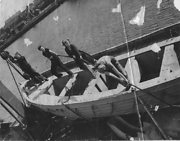 Donated by Hartlepool Museum Service
Donated by Hartlepool Museum ServiceFour women in a lifeboat aboard a ship. Ship believed to be The Empire Nigel.
More detail » Frame Bending
Frame Bending
 Part of the Hartlepool Library Services collection
Part of the Hartlepool Library Services collectionFrame bending at Central Yard
More detail » Frank Andrews
Frank Andrews
 Created by unknown
Donated by Lynn Gowland
Created by unknown
Donated by Lynn GowlandFrank "Pipes" Andrews with a group of family members in his ferryboat.
More detail » Gas Works Bridge
Gas Works Bridge
 Created by Bill Boagey
Donated by Hartlepool Museum Service
Created by Bill Boagey
Donated by Hartlepool Museum ServicePart of the Bill Boagey collection
Bridge near the Gas Works on the docks.
More detail » Gentry on the docks
Gentry on the docks
 Donated by Hartlepool Museum Service
Donated by Hartlepool Museum ServiceDock head 1909, removal of the lock gates and this land to open the entrance to the harbour. The Dock Hotel in the background which was at the bottom of Southgate.
Shows a group of well-dressed men and women standing on the dockside. Travelling crane shown in the background on the left. A very early steam locomotive can be seen to the left and above travelling crane.
More detail » Giant 4 oil platform
Giant 4 oil platform
 Donated by Hartlepool Library Service
Donated by Hartlepool Library ServiceGiant 4 oil platform in dock at Heerema. The Carnegie building, Northgate, to the right.
HHT&nN 272
More detail » Giant 4 oil platform
Giant 4 oil platform
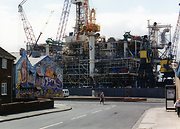 Donated by Hartlepool Library Service
Donated by Hartlepool Library ServiceGiant 4 oil platform in Dock. The mural on the left of the picture was on the Headland Gate PH, previously Il Ponte and The Bridge. The pub has now been demolished.
HHT&N 274
More detail » Gray's Dockyard
Gray's Dockyard
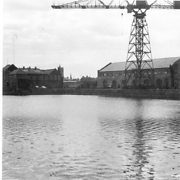 Donated by Hartlepool Museum Service
Donated by Hartlepool Museum ServicePart of the Shipbuilding collection
Dated 1968
Gray's Dockyard taken from 'A' jetty Union Dock. Building behind the crane was the Museum of Hartlepool now part of the National Museum of the Royal Navy.
More detail » Grays Dockyard - 1920
Grays Dockyard - 1920
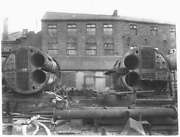 Created by unknown
Donated by Douglas Ferriday
Created by unknown
Donated by Douglas FerridayPart of the Hartlepool Library Services collection
Ship's boilers being repaired behind the fitting shop at Gray's dockyard, Hartlepool c.1920.
More detail » Grays Offices 1970
Grays Offices 1970
 Created by Douglas Ferriday
Donated by Hartlepool Library Service
Created by Douglas Ferriday
Donated by Hartlepool Library ServiceGables and a chimney on the side of Gray's offices, West Dock, Hartlepool, 1970.
More detail » Greenland
Greenland
 Created by Bill Boagey
Donated by Hartlepool Museum Service
Created by Bill Boagey
Donated by Hartlepool Museum ServicePart of the Bill Boagey collection
Rail Lines on Dockland
More detail » Greenland area
Greenland area
 Created by Bill Boagey
Donated by Hartlepool Museum Service
Created by Bill Boagey
Donated by Hartlepool Museum ServicePart of the Bill Boagey collection
Greenland area. Middleton Road with gas holder and railtracks into docks.
More detail » Handrails on MV Mabel Warwick
Handrails on MV Mabel Warwick
 Donated by Hartlepool Museum Service
Donated by Hartlepool Museum ServiceHandrails on MV Mabel Warwick.
More detail » Harbour Street
Harbour Street
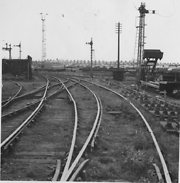 Created by Bill Boagey
Donated by Hartlepool Museum Service
Created by Bill Boagey
Donated by Hartlepool Museum ServicePart of the Bill Boagey collection
Harbour Street on the docks, with rail lines leading to timber yards.
More detail » Harbour Yard Platers 1911
Harbour Yard Platers 1911
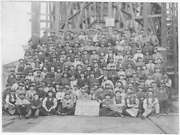 Part of the Hartlepool Library Services collection
Part of the Hartlepool Library Services collectionA group photo of the Irvine's Harbour Yard Platers from 1911.
More detail » Hartlepool Sea Front from the air
Hartlepool Sea Front from the air
 Donated by Hartlepool Library Service
Donated by Hartlepool Library ServiceHartlepool Sea Front from the air. Newburn Bridge is where the bend in the road is. The road to the right of this is Mainsforth Terrace. The Docks can be seen top right.
More detail » Hatch covers
Hatch covers
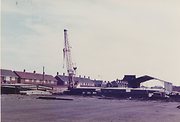 Created by Francis Elsdon
Donated by Hartlepool Museum Service
Created by Francis Elsdon
Donated by Hartlepool Museum ServicePart of the Elsdon Collection collection
Hatch covers on Victoria Dock. Now part of Heerema'a works. ready for transport.
More detail » History of the Docks at Hartlepool
History of the Docks at Hartlepool
Origin of Hartlepool’s Railways and Docks
The situation before 1800
The beginning of the docks in the Hartlepools goes back to the late 18th century. At that time Hartlepool was a small coastal town whose inhabitants for the most part made their living from fishing. The town had been important in the middle ages, when the Bishop of Durham had used it as a port to import his supplies. Since then the inland harbour had fallen into serious disrepair. The harbour had silted up and had even had crops grown on it. In 1795 the population of Hartlepool was only about a thousand.
With the industrial revolution, which started to get going at the end of the 18th century, there was an increased demand for coal, to fuel the new machines being developed at the time. Coal was also used in the making of glass and the smelting of iron and other metals.
There were collieries a few kilometres inland from Hartlepool. The coal had to be carried from the collieries to ships, and then taken to London. At that time there were very few railways, and the wagons were hauled by horses. The waggonway ended at Stockton-on-Tees. The ships travelled up the river Tees to Stockton, and loaded the coal there.
There was no coal near to Hartlepool, a fact proved in 1735 by testing nearby, but in 1795 Mr R. Dodd, a surveyor, was asked to make a report on the condition of the old harbour and slake (a large area of inland water which almost cut off the outcrop of land on which Hartlepool was built from the mainland). His report recognised the possibilities of the site and said it could make a harbour to accommodate the entire English Navy. Mr Dodd made the first mention of a Harbour of Refuge. He also estimated that the price for creating a harbour would be £21,537. 4s 8d (£1,203,736.00 in today’s money) including a lighthouse. But there was no money available, so no action was taken.
Coal and the Railways, early 1800s
A local disaster
At Hartlepool, in 1810, the end of the harbour pier collapsed. Money was raised locally for the repairs, but it was not enough. In 1813 a Bill was put through Parliament, making funds available, but these had to be recovered by a charge on cargo shipped through the port. The Port & Harbour Commission came into being as part of the 1813 Act.
The Stockton Darlington Railway
On 18th September 1810, a banquet and meeting was held in the Town Hall, at Stockton. It celebrated the opening of a cut in the River Tees to straighten out the river and thus help ships coming to Stockton. The River Tees followed a very winding course, with many sandbanks, which made it very difficult to navigate. At the meeting they formed a committee to consider building either a railway or canal for bringing coal to the Tees. Between 1812 and 1818 surveys were done and discussions held. After considering building a canal, it was decided to build a railway between Stockton and Darlington. This required an Act of Parliament. Permission was finally granted in April 1820, and work began in 1823. In September 1825, the Stockton Darlington Railway opened. As well as carrying coal, it could also transport people. This was the first passenger railway in the world.
An idea that fell through
In 1823 Hetton Coal Company had an idea to use Hartlepool for their outlet for coals. Coal drops, to load the coal onto the ships, would be built on the north side of the old harbour. The plan fell through owing to the death of the principal partner, and other factors within the coal company.
The Rivals
Seaham Harbour was opened on 31st July 1831. It was on the estate of the Marquis of Londonderry, who ordered its construction. On 23rd May 1828 an Act of Parliament became law for Clarence Railway to take coal to Port Clarence. Christopher Tennant, a railway promoter from Stockton, took the bill through Parliament. This meant that ships were coming to ports nearby, both to the north and south of Hartlepool, but not to Hartlepool itself.
The Building of Hartlepool Harbour and Victoria Docks
With a railway to Port Clarence to the south of Hartlepool, and Seaham Harbour to the north, the people of Hartlepool realised that they would lose out on a profitable trade if they did nothing. So in 1831 the Hartlepool Dock and Railway Company was set up. A bill making it official went through Parliament on 1st June 1832. In that year Christopher Tennant moved to Hartlepool, to take up the official capacity of superintendent of works.
Stockton may have been nearer than Hartlepool to the collieries, but it was hard to get the coal to the sea.
In 1833 the Clarence Railway, another Christopher Tennant enterprise, was completed, ending its journey at the edge of the river Tees at Port Clarence, a few kilometres down river from Stockton. The following year the first cargo of coal was shipped from Port Clarence in the brig Elizabeth of London. Stockton and Port Clarence were not well placed for coal shipments because of the difficulty in navigating the river. The time it took to get from London to the mouth of the Tees (about 490 kilometres) was sometimes no longer than it took from the mouth of the Tees to Stockton (about twenty four kilometres). Over the following three years, the line did not make money because of the navigation problems. At some points on the river, the larger ships had to be towed by a horse. Christopher Tennant had the idea to extend the Clarence Railway, to bring the line to Hartlepool.
Hartlepool eventually proved more profitable
After much difficulty, the Harbour at Hartlepool was opened on July 1st 1835. In the same year it was realised that a pier was needed on the Middleton side of channel to protect incoming ships from the currents. The first cargo of coal from Thornley Colliery was shipped at Hartlepool in the brig Britannia. South Hetton Coal Company was the next customer. By 1850 there were eighteen collieries shipping coal from Hartlepool. The channel into the Harbour was in a bad state, however. The Hartlepool Dock Co. had to finance the Port and Harbour Commissioners to make improvements.
Building the railway to Hartlepool
In 1839 a Bill was passed giving powers to construct new line for the new Stockton and Hartlepool Railway Company. It became known as the “Junction” Line. In the same year, on 12th September, Christopher Tennant died suddenly at Leeds. He never saw the new line completed, which opened in February 1841.
Victoria Dock – the first of Hartlepool’s docks
In December 1840, the Victoria Dock at Hartlepool was opened. The amount of tonnage shipped in 1840 was already almost double that handled the previous year.
By 1851 the dock had sixteen coal drops (machinery to get the coal from the wagon to the ship) and three steam operated ballast cranes, which took solid ballast (something heavy to hold an empty ship down in the water) away from the ships. The brig Thomas Sewell was the first ship to enter and load in the new dock.
The argument between the Railway Companies
The town of West Hartlepool came into being as a result of a row between the Hartlepool Railway and Dock Company (HR&DC) and Stockton and Hartlepool Railway Company (S&HRC). HR&DC was in existence before S&HRC with line of its own to the north to Thornley and Wingate. The root of the argument was that HR&DC charged S&HRC too much money to use their railway line.
“The Stockton and Hartlepool Railway Company” (S&HRC) came about because the export of coal from Port Clarence proved disappointing, so the idea was formed to continue Clarence Railway from Billingham to Hartlepool. A new company was needed –It was promoted by Christopher Tennant and others, including Ralph Ward Jackson. An alternative idea was to build a link to HR&DC, called the Union Railway, to link with the existing line. Christopher Tennant was involved in all three concerns – the Clarence Railway, S&HRC, and HR&DC.
What the papers said
The Sunderland News and North of England Advertiser said on June 5, 1852 –
“The new docks at Hartlepool furnishing a safe and convenient egress for vessels, where they are frequently windbound, an extension to Hartlepool of the Stockton and Clarence Railway, for the convenience of the collieries in that district, was projected in the year 1838. An act was obtained, and the new line opened in 1841. An agreement for three years was entered into with the Dock and Railway Company for leave to ship coals at the Hartlepool Dock. The terms, however were unsatisfactory, the dues being high; and this limiting the supply of coals at Hartlepool, the Hartlepool line proved unrenumerative. The old company, secure in their monopoly, disregarded all representations in favour of a reduction – foolishly preferring a small traffic with an exorbitant profit than a large one at more moderate charges. The parties connected with the railway had thus the consideration forced upon them of constructing docks of their own.”
The dispute between Hartlepool Railway and Dock Company and Stockton and Hartlepool Railway Company
On 4th February 1841 the line from Billingham was opened. The original idea was that it should go to the Victoria Dock at Hartlepool. The dues set by the Hartlepool dock company were too high, however, causing much disagreement and rivalry between the two companies. Many pamphlets were printed, stating the case for either side. At the end of the three year contract, the business relationship had become much worse, and the agreement was not renewed.
The solicitor for the S&HRC was Ralph Ward Jackson, who had a successful legal practice in Stockton. He decided to build a dock and harbour on the coast at Stranton, a small village to the south of Hartlepool, thereby taking business away from Hartlepool. The first choice of site was on the Slake, near to Hartlepool, but this was prevented by HR&DC, who were the owners.
The shipwrecks that convinced Parliament
Ralph Ward Jackson put a bill through Parliament to gain permission to build his dock and harbour, amidst heavy opposition from the supporters of HR&DC. But on 16th February 1844 eight ships were wrecked on the beach where West Hartlepool was proposed. The proposal had valuable support from the eight sea captains, who stated that had the harbour been there, their ships would not have been lost. So on 23rd September 1844 the bill received Royal Assent, which allowed Ralph Ward Jackson to form the new company to build a new harbour and dock at what became West Hartlepool. The new company was called the West Harbour and Dock Company (WH&DC).
In January 1845 the first sod of Coal Dock was cut, and in April that year Ralph Ward Jackson laid the foundation stone of the outer harbour works. Not long after these events, in 1846, the York and Newcastle Railway Company took over HR&DC.
Opening of three docks at Stranton - Birth of the town of West Hartlepool
Coal Dock & harbour – the beginning of the rebellion
The bill to build the harbour and dock at West Hartlepool was finally passed in Parliament in September 1844. The work began on the dock the following January and on the outer harbour in April the same year. The railway line from Billingham to Hartlepool was cut off and diverted to the new works. Coal drops or staiths were built at Harbour Terrace, which was near where the earliest houses were built.
Bringing in the money
The West Hartlepool Harbour and Docks opened on 1st June 1847. It covered an area of 8 acres. Ward Jackson encouraged businessmen to set up in West Hartlepool, among these were the shipbuilders Irvine and Pile, and Lauder’s timber yard and sawmill. The docks also provided “refuge and shelter to a vast number of ships” during gales. The new docks did not affect trade at the Victoria Dock in Hartlepool, and both companies prospered. The first barque to enter the dock was Prince, commanded by Captain Black, from Jersey.
Jackson Dock – and fresh fish
The Coal Dock soon became too small for the amount of traffic that used it, making it necessary to build a further dock. Jackson Dock opened 1st June 1852.
“a noble monument to the enterprise and judgement of the West Hartlepool Dock Co and especially to their chairman, Ralph Ward Jackson” was the comment from the Sunderland News
The dock covered an area of fourteen acres. At the upper (west) side was a graving dock, for ship repairs.
On the same day the railway was opened by Leeds Northern Railway, which connected West Hartlepool with Leeds, Halifax, Huddersfield, Wakefield, Bradford, Manchester, Liverpool and Preston. This opened up a trade route to the large inland towns in Yorkshire, taking fresh fish to the cities.
Swainson Dock – the opening that went with a bang and lots of fizz
Swainson Dock was opened on the 3rd June 1856, it would have been the third dock to be opened on 1st June, but that date fell on a Sunday. The dock was named after Ralph Ward Jackson’s father-in-law.
The opening of Swainson Dock was an even grander affair than the opening of the two earlier docks. The ceremony started at eight o’ clock in the morning with a procession of ships entering the new dock.
Something happened during the entry of the ships, which could have been very nasty. As a ship called the Zingari was passing through the West Lock, one of its cannons was fired. The ship was immediately opposite Captain John Pigg, the Harbour Master, and the explosion took away the tails of his coat and “the greater part of his small-clothes”. Fortunately the cannon was filled with blank-shot so he was not seriously injured. He was able to find some replacement clothing in time to attend the banquet which took place after the procession.
Following the procession, a banquet was held in a marquee (a very large tent) nearby. The weather that day was windy, and the wind blew the top off the tent, so people dined in the open air. An observer at the time reported that 800 sat down to dinner that day. He also said that they drank 1440 bottles of champagne. Some of the people had never tried champagne before and got drunk. This included all the waiters, who had to be removed from the tent by policemen
Thousands of visitors from near and far
Special trains were laid on to bring thousands of visitors from Leeds, a hundred kilometres to the south, in Yorkshire, and Newcastle, forty kilometres to the north. There were international visitors too, from Prussia and Germany. They were invited so that they would recommend the new docks as an excellent trading centre amongst their colleagues in their home countries. The opening of the new dock was talked and written about, with lengthy reports in the local papers.
The North Eastern Railway Company
The North Eastern Railway Company (NER) came into existence in 1854. It was made up of the amalgamated companies of the York and Newcastle Railway Co. and the Hartlepool Dock and Railway Co. They joined forces with the York, Newcastle and Berwick Railway Co. in 1847. When the NER was set up, it took control of the docks at old Hartlepool.
NER acquires West Hartlepool Docks
NER did not acquire the West Hartlepool dock and harbour until 1st July 1865. In 1861 Ralph Ward Jackson had been forced to resign from the West Hartlepool Harbour and Railway Company. This followed a dispute between him and a man called Benjamin Coleman, who originally had an argument with Ward Jackson’s brother, Edwin.
At the time both Hartlepool and West Hartlepool harbours and docks came under the same ownership, there was a local recession and uncertainty, as the management did not disclose their plans for the two ports. By 1870, the NER had gained five seats on the Port and Harbour Commission, including the chairmanship, giving them a say in how the two ports should be run. The situation was the same ten years later, according to printed lists in the Robert Wood Collection of Ephemera.
Hartlepool and West Hartlepool Docks are united
It was the NER that completed the large task of joining up the two sets of docks, those at Hartlepool and the ones at West Hartlepool. The work was started in 1875, and completed in 1880. Ships could enter Hartlepool harbour and from there would move through a newly built North Basin, Central Dock and Union Dock to gain entry into the Swainson, Jackson and Coal Docks. The Basin had a lock at each end, so larger ships had a much easier entrance into the docks than through Ward Jackson’s harbour and locks, which were built to provide for the smaller ships that were built forty years previously
Trade in the Hartlepools in the 20th century
The large sum of money that NER invested in the Hartlepool dock system was justified by the company’s use of the docks. Merchants were enticed to bring their cargo to the Hartlepools by competitive rates and other encouragements. This resulted in the development of a large local timber trade, supplying the Durham collieries with pit props, as well as the Yorkshire mines, inland.
There was also a thriving trade in steamers, and a regular route from the Hartlepools to the ports surrounding the Baltic Sea during the months when the Baltic was free of ice.
The Hartlepools’ main trades in the first half of the 20th century were iron ore coming into the port, and coal going out, and pit props and sawn wood. There was a little liner business and some other trade including scrap for steel making. The ship building firms added income to the ports’ coffers, and needed the help of support industries, such as local Lloyd’s register staff, a compass adjustor and offices related to ship owning.
The fate of the NER and LNER
NER continued to amalgamate with smaller railways and later owned Middlesbrough dock. In 1923 a further amalgamation with Hull, Immingham and Grimsby was part of the formation of the London and North Eastern Railway (LNER), which posed a threat to Hartlepool through increased competition.
From 1st January, 1923, the LNER was made up of the North Eastern Railway, the Great Northern Railway, the Great Central Railway, the Great Eastern Railway and two Scottish Railways, the Great North of Scotland Railway and the North British Railway. The LNER ceased to exist when the railway companies were nationalised.
More detail » Irvine's Harbour Yard
Irvine's Harbour Yard
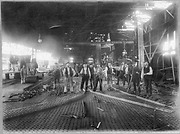 Donated by Hartlepool Library Service
Donated by Hartlepool Library ServicePart of the Hartlepool Library Service collection
Frame bonding at Irvines Harbour Yard, Hartlepool.
More detail » Irvine's Quay - Middleton Shipyard (1)
Irvine's Quay - Middleton Shipyard (1)
 Donated by Hartlepool Museum Service
Donated by Hartlepool Museum ServiceIrvine's Quay, Middleton Shipyard showing method of construction. Swan Neck Crane and CMEW Hammer Head Crane in the background.
More detail » Irvine's Quay - Middleton Shipyard (2)
Irvine's Quay - Middleton Shipyard (2)
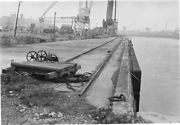 Donated by Hartlepool Museum Service
Donated by Hartlepool Museum ServiceAn apparently derelict Irvine's Quay, Middleton Shipyard. The Swan-neck crane is visible in the background.
More detail » Irvines Quay, Middleton Shipyard
Irvines Quay, Middleton Shipyard
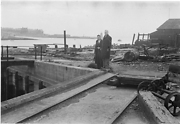 Donated by Hartlepool Museum Service
Donated by Hartlepool Museum ServiceTwo men stood on Irvine's Quay, Middleton Shipyard. Area appears derelict.
More detail » Ivy of Leith in Hartlepool
Ivy of Leith in Hartlepool
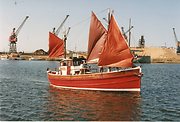 Donated by Hartlepool Museum Service
Donated by Hartlepool Museum ServicePart of the Fishing collection
Ivy of Leith in Hartlepool. It looks like the vessel has been converted for pleasure.
More detail » J Allan Ross
J Allan Ross
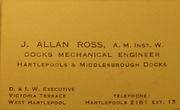 Donated by W Henderson
Donated by W HendersonPart of the Business Cards collection
Business card for J Allan Ross, A.M. Inst. W., Docks Mechanical Engineer, Hartlepool & Middlesbrough Docks.
More detail » J H Pounder Boat Builders (2)
J H Pounder Boat Builders (2)
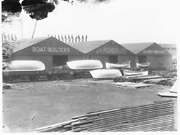 Donated by Douglas Ferriday
Donated by Douglas FerridayPart of the Hartlepool Library Services collection
Ship's Lifeboats loaded onto railway trucks ready for transportation at J.M. Pounder's boatyard near Throston Bridge, Hartlepool. c1920
HHT&N 824
More detail » J H Pounder Boat Builders (1)
J H Pounder Boat Builders (1)
 Donated by Douglas Ferriday
Donated by Douglas FerridayPart of the Hartlepool Library Services collection
Boats being built at J.M. Pounder's boatyard near Throston Bridge, Hartlepool. c.1930.
HHT+N 796
More detail » J H Pounder Boat Builders (3)
J H Pounder Boat Builders (3)
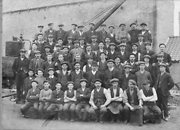 Part of the Hartlepool Library Services collection
Part of the Hartlepool Library Services collectionMen from J. H. Pounders posing for the camera. Date not known.
More detail » Jackson Dock
Jackson Dock
 Donated by F.Wilson
Donated by F.WilsonTaken probably in the late 1950s/ early 1960s of Jackson Dock.
The Old West Quay and Premier Inn would now be facing the camera and in the distance on the left across union Dock is Middleton Road. Coal trucks can be seen in the centre.
More detail » Jim Callaghan at the docks
Jim Callaghan at the docks
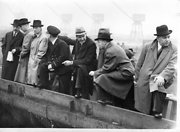 Donated by Hartlepool Library Service
Donated by Hartlepool Library ServiceJim Callaghan, labour politician, visiting Hartlepool Docks. He is the man pointing.
HHT&N 383
More detail » Kafiga Landings
Kafiga Landings
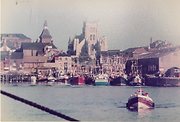 Created by Francis Elsdon
Donated by Hartlepool Museum Service
Created by Francis Elsdon
Donated by Hartlepool Museum ServicePart of the Elsdon Collection collection
A view of the Kafiga Landings and the Fish Quay.
More detail » Lifting Bridge section of Windward Passage
Lifting Bridge section of Windward Passage
 Donated by Hartlepool Library Service
Donated by Hartlepool Library ServiceLifting Bridge section of Windward Passage by CMEW crane in the North Basin.
More detail » Loading coal on to a ship
Loading coal on to a ship
 Donated by Hartlepool Library Service
Donated by Hartlepool Library ServiceLoading coal on to a ship from the coal staithes using an electric conveyor belt.
HHT&N 332
More detail » Lock Gates
Lock Gates
 Donated by Douglas Ferriday
Donated by Douglas FerridayPart of the Hartlepool Library Service collection
Lock Gates in the Hartlepool Dock. CMEW works to the left.
More detail » Lock Gates 2
Lock Gates 2
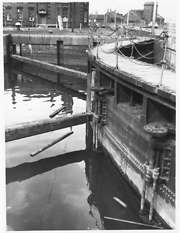 Donated by Douglas Ferriday
Donated by Douglas FerridayPart of the Hartlepool Library Service collection
Lock Gates next to the Dockmaster's Offices at Jackson Dock. Have now been replaced.
More detail » Lock Gates renewal
Lock Gates renewal
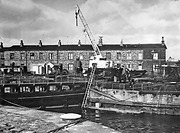 Donated by Hartlepool Library Service
Donated by Hartlepool Library ServiceSome debate as to whether this show the lock gates being repaired or renewed. There seems to be bits of old machinery in the background that could have come from the old swing bridge. Harbour Terrace, Middleton, in the background.
HHT+N 779
More detail » Low tide
Low tide
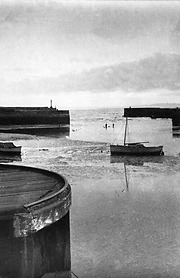 Donated by Hartlepool Library Service
Donated by Hartlepool Library ServiceLooking out between two piers at low tide at Hartlepool Docks. It look like two men in the centre. Probably bait digging.
More detail » MV Algerian Express
MV Algerian Express
 Created by Francis Elsdon
Donated by Hartlepool Museum Service
Created by Francis Elsdon
Donated by Hartlepool Museum ServicePart of the Elsdon Collection collection
MV Algerian Express in the deep water berth, Hartlepool.
More detail » MV Alpha (Germany)
MV Alpha (Germany)
 Created by Francis Elsdon
Donated by Hartlepool Museum Service
Created by Francis Elsdon
Donated by Hartlepool Museum ServicePart of the Elsdon Collection collection
Dated 1976
MV Alpha (Germany) in Union Dock, Hartlepool.
More detail » MV Autobahn
MV Autobahn
 Created by Francis Elsdon
Donated by Hartlepool Museum Service
Created by Francis Elsdon
Donated by Hartlepool Museum ServicePart of the Elsdon Collection collection
Dated 1987
MV Autobahn in the Central Dock, Hartlepool.
More detail » MV Bow Forest
MV Bow Forest
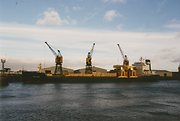 Created by Francis Elsdon
Donated by Hartlepool Museum Service
Created by Francis Elsdon
Donated by Hartlepool Museum ServicePart of the Elsdon Collection collection
MV Bow Forest in the deep water berth, Hartlepool.
More detail » MV Brouage
MV Brouage
 Created by Francis Elsdon
Donated by Hartlepool Museum Service
Created by Francis Elsdon
Donated by Hartlepool Museum ServicePart of the Elsdon Collection collection
Dated 1987
MV Brouage at berth in the Union Dock.
More detail » MV Captain J M Donaldson
MV Captain J M Donaldson
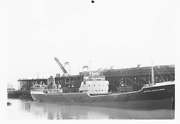 Part of the Hartlepool Library Services collection
Part of the Hartlepool Library Services collectionM.V. Captain J. M. Donaldson alongside the coal staithes at Hartlepool Dock.
More detail » MV Carelia
MV Carelia
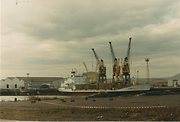 Created by Francis Elsdon
Donated by Hartlepool Museum Service
Created by Francis Elsdon
Donated by Hartlepool Museum ServicePart of the Elsdon Collection collection
MV Carelia at Berth in the North Basin.
More detail » MV Finnalpino
MV Finnalpino
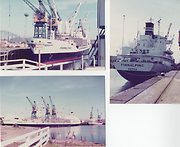 Created by Francis Elsdon
Donated by Hartlepool Museum Service
Created by Francis Elsdon
Donated by Hartlepool Museum ServicePart of the Elsdon Collection collection
Dated 1982
MV Finnalpino at berth at the Deep Water Berth, Hartlepool.
More detail » MV Finnoak
MV Finnoak
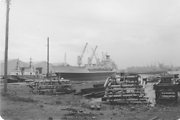 Created by Francis Elsdon
Donated by Hartlepool Museum Service
Created by Francis Elsdon
Donated by Hartlepool Museum ServicePart of the Elsdon Collection collection
Dated 1977
MV Finnoak at the Linkflow Quay, Hartlepool.
More detail » MV Foxtongate
MV Foxtongate
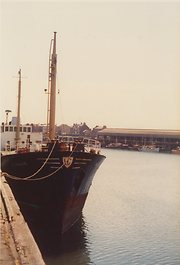 Created by Francis Elsdon
Donated by Hartlepool Museum Service
Created by Francis Elsdon
Donated by Hartlepool Museum ServicePart of the Elsdon Collection collection
Dated 1974
MV Foxtongate berthed at the Wood Quay opposite the Fish Quay, Hartlepool.
More detail » MV Gera
MV Gera
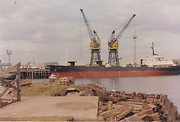 Created by Francis Elsdon
Donated by Hartlepool Museum Service
Created by Francis Elsdon
Donated by Hartlepool Museum ServicePart of the Elsdon Collection collection
Dated 1986
MV Gera in the Deep Water Berth, Hartlepool.
More detail » MV Gerard L D
MV Gerard L D
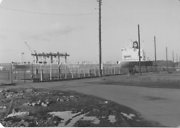 Created by Francis Elsdon
Donated by Hartlepool Museum Service
Created by Francis Elsdon
Donated by Hartlepool Museum ServicePart of the Elsdon Collection collection
Dated 1976
MV Gerard L D in the Deep Water Berth, Hartlepool.
More detail » MV Heide-Catrin
MV Heide-Catrin
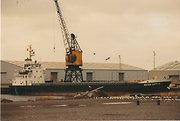 Created by Francis Elsdon
Donated by Hartlepool Museum Service
Created by Francis Elsdon
Donated by Hartlepool Museum ServicePart of the Elsdon Collection collection
Dated 1988
MV Heide-Catrin in the North Basin, Hartlepool.
More detail » MV Hugo Brinkman
MV Hugo Brinkman
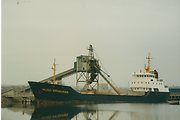 Created by Francis Elsdon
Donated by Hartlepool Museum Service
Created by Francis Elsdon
Donated by Hartlepool Museum ServicePart of the Elsdon Collection collection
Dated 1987
MV Hugo Brinkman in Central Dock, Hartlepool.
More detail » MV Irati
MV Irati
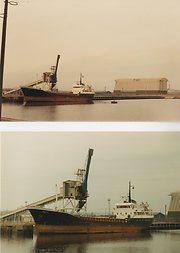 Created by Francis Elsdon
Donated by Hartlepool Museum Service
Created by Francis Elsdon
Donated by Hartlepool Museum ServicePart of the Elsdon Collection collection
Dated 1987
MV Irati. Two shots of the MV Irati in the Central Dock.
More detail » MV Kassantina
MV Kassantina
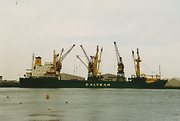 Created by Francis Elsdon
Donated by Hartlepool Museum Service
Created by Francis Elsdon
Donated by Hartlepool Museum ServicePart of the Elsdon Collection collection
Dated 1989
MV Kassantina at berth in the Deep Water Berth, Hartlepool.
More detail » MV Kopalnia Zofiowka
MV Kopalnia Zofiowka
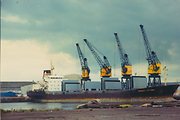 Created by Francis Elsdon
Donated by Hartlepool Museum Service
Created by Francis Elsdon
Donated by Hartlepool Museum ServicePart of the Elsdon Collection collection
Dated 1987
MV Kopalnia Zofiowka in the Deep Water Berth, Hartlepool.
More detail » MV Largo
MV Largo
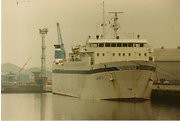 Created by Francis Elsdon
Donated by Hartlepool Museum Service
Created by Francis Elsdon
Donated by Hartlepool Museum ServicePart of the Elsdon Collection collection
Dated 1987
MV Largo at the Linkflow Quay, Hartlepool.
More detail » MV Link Star
MV Link Star
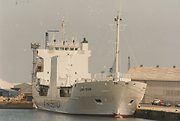 Created by Francis Elsdon
Donated by Hartlepool Museum Service
Created by Francis Elsdon
Donated by Hartlepool Museum ServicePart of the Elsdon Collection collection
MV Link Star at berth at the Linkflow Quay, Hartlepool.
More detail » MV Mabel Warwick
MV Mabel Warwick
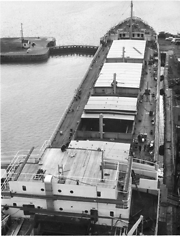 Donated by Hartlepool Museum Service
Donated by Hartlepool Museum ServiceMV Mabel Warwick at berth. Picture taken from the CMEW Crane.
More detail » MV Maja
MV Maja
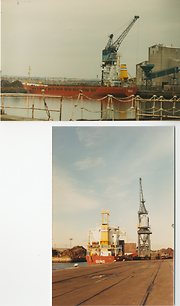 Created by Francis Elsdon
Donated by Hartlepool Museum Service
Created by Francis Elsdon
Donated by Hartlepool Museum ServicePart of the Elsdon collection
Dated 1987
MV Maja. Two shots of the Maja at berth in the Union Dock.
More detail » MV Mielec (Poland)
MV Mielec (Poland)
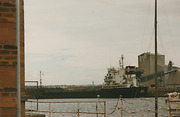 Created by Francis Elsdon
Donated by Hartlepool Museum Service
Created by Francis Elsdon
Donated by Hartlepool Museum ServicePart of the Elsdon Collection collection
Dated 1988
 MV Olympia Carrier
MV Olympia Carrier
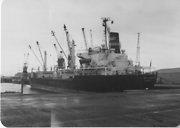 Created by Francis Elsdon
Donated by Hartlepool Museum Service
Created by Francis Elsdon
Donated by Hartlepool Museum ServicePart of the Elsdon Collection collection
Dated 1979
MV Olympia Carrier in the Deep Water Berth, Hartlepool.
More detail » MV Paper Trader
MV Paper Trader
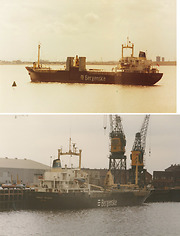 Created by Francis Elsdon
Donated by Hartlepool Museum Service
Created by Francis Elsdon
Donated by Hartlepool Museum ServicePart of the Elsdon Collection collection
Dated 1985
MV Paper Trader in the Deep Water Berth, Hartlepool.
More detail » MV Peter Faber
MV Peter Faber
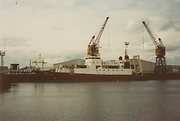 Created by Francis Elsdon
Donated by Hartlepool Museum Service
Created by Francis Elsdon
Donated by Hartlepool Museum ServicePart of the Elsdon Collection collection
MV Peter Faber at berth in the Deep Water Berth, Hartlepool.
More detail » MV Pool Fisher
MV Pool Fisher
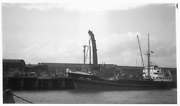 Part of the Hartlepool Library Services collection
Part of the Hartlepool Library Services collectionThe Motor Vessel Pool Fisher in the Old Harbour, Hartlepool, with the Swan-Neck crane in the background.
More detail » MV Sagacity (Everard)
MV Sagacity (Everard)
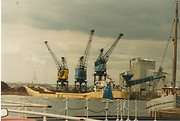 Created by Francis Elsdon
Donated by Hartlepool Museum Service
Created by Francis Elsdon
Donated by Hartlepool Museum ServicePart of the Elsdon Collection collection
MV Sagacity (Everard) at berth in Union Dock, Hartlepool.
More detail » MV Saint Angus
MV Saint Angus
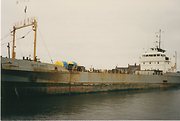 Created by Francis Elsdon
Donated by Hartlepool Museum Service
Created by Francis Elsdon
Donated by Hartlepool Museum ServicePart of the Elsdon Collection collection
Dated 1988
MV Saint Angus in Union Dock, Hartlepool.
More detail » MV Samjohn Pioneer
MV Samjohn Pioneer
 Created by Francis Elsdon
Donated by Hartlepool Museum Service
Created by Francis Elsdon
Donated by Hartlepool Museum ServicePart of the Elsdon Collection collection
Dated 1988
MV Samjohn Pioneer in the Deep Water Berth, Hartlepool.
More detail » MV Santoni
MV Santoni
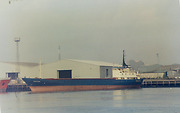 Created by Francis Elsdon
Donated by Hartlepool Museum Service
Created by Francis Elsdon
Donated by Hartlepool Museum ServicePart of the Elsdon Collection collection
MV Santoni at berth at the Linkflow Quay, Hartlepool
More detail » MV Seebrise (Germany)
MV Seebrise (Germany)
 Created by Francis Elsdon
Donated by Hartlepool Museum Service
Created by Francis Elsdon
Donated by Hartlepool Museum ServicePart of the Elsdon Collection collection
MV Seebrise (Germany) at berth in the North Basin, Hartlepool.
More detail » MV Speciality
MV Speciality
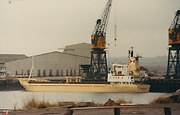 Created by Francis Elsdon
Donated by Hartlepool Museum Service
Created by Francis Elsdon
Donated by Hartlepool Museum ServicePart of the Elsdon Collection collection
Dated 1987
MV Speciality in the Deep Water Berth, Hartlepool.
More detail » MV Sperus
MV Sperus
 Created by Francis Elsdon
Donated by Hartlepool Museum Service
Created by Francis Elsdon
Donated by Hartlepool Museum ServicePart of the Elsdon Collection collection
Dated 1977
MV Sperus in the Deep Water Berth, Hartlepool.
More detail » MV Steinfalk
MV Steinfalk
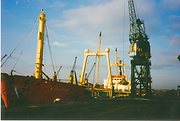 Created by Francis Elsdon
Donated by Hartlepool Museum Service
Created by Francis Elsdon
Donated by Hartlepool Museum ServicePart of the Elsdon Collection collection
Dated 1989
MV Steinfalk in Union Dock, Hartlepool.
More detail » MV Steyning
MV Steyning
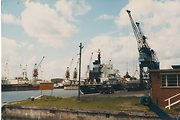 Created by Francis Elsdon
Donated by Hartlepool Museum Service
Created by Francis Elsdon
Donated by Hartlepool Museum ServicePart of the Elsdon Collection collection
Dated 1987
MV Steyning in the Union Dock. Picture taken from Middleton Road Swing Bridge.
More detail » MV Titanian
MV Titanian
 Donated by Hartlepool Museum Service
Donated by Hartlepool Museum ServiceTitanian & Winward Passage which became Fabian. Picture taken in Graythorp dry dock.
More detail » MV Titanian
MV Titanian
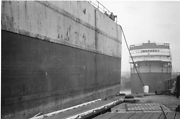 Donated by Hartlepool Museum Service
Donated by Hartlepool Museum ServiceMV Titanian being lined up for joining to Windward Passage Bridge section. This took place in Graythorp dry dock.
More detail » MV Titanian
MV Titanian
 Donated by Hartlepool Museum Service
Donated by Hartlepool Museum ServiceMV Titanian. Hull being married to Windward Passage's bridge Section in Graythorp Dry Dock.
More detail » MV Titanian
MV Titanian
 Donated by Hartlepool Museum Service
Donated by Hartlepool Museum ServiceMV Titanian. Fore end od Titanium in dry dock to be joined to Windward Passage's Bridge section.
More detail » MV Titanian
MV Titanian
 Donated by Hartlepool Museum Service
Donated by Hartlepool Museum ServiceMV Titanian. Hull being married to Windward Passage's bridge Section in Graythorp Dry Dock.
More detail » MV Titanian
MV Titanian
 Donated by Hartlepool Museum Service
Donated by Hartlepool Museum ServiceMV Titanian. New boiler being lifted on board in the CMEW yard during the 1930s.
More detail » MV Titanian
MV Titanian
 Donated by Hartlepool Museum Service
Donated by Hartlepool Museum ServiceFore end of Titanian being towed into Graythorp dry dock by tug Caedmon Cross.
More detail » MV Titanian
MV Titanian
 Donated by Hartlepool Museum Service
Donated by Hartlepool Museum ServiceMV Titanian. New boiler being lifted on board in the CMEW yard during the 1930s.
More detail » MV Titanian
MV Titanian
 Donated by Hartlepool Museum Service
Donated by Hartlepool Museum ServiceMV Titanian. New boiler being lifted on board in the CMEW yard during the 1930s.
More detail » MV Titanian
MV Titanian
 Donated by Hartlepool Museum Service
Donated by Hartlepool Museum ServiceMV Titanian. New boiler being lifted on board in the CMEW yard during the 1930s.
More detail » MV Titanian
MV Titanian
 Donated by Hartlepool Museum Service
Donated by Hartlepool Museum ServiceMV Titanian. New boiler being lifted on board in the CMEW yard during the 1930s.
More detail » MV Titanian
MV Titanian
 Donated by Hartlepool Museum Service
Donated by Hartlepool Museum ServiceMV Titanian. New boiler being lifted on board in the CMEW yard during the 1930s.
More detail » MV Titanian
MV Titanian
 Donated by Hartlepool Museum Service
Donated by Hartlepool Museum ServiceShowing the joining of the Titanian and the Windward Passage in Graythorp dry dock in 1961.
More detail » MV Titanian
MV Titanian
 Donated by Hartlepool Museum Service
Donated by Hartlepool Museum ServiceMV Titanian. New boiler being lifted on board in the CMEW yard during the 1930s.
More detail » MV Titanian
MV Titanian
 Donated by Hartlepool Museum Service
Donated by Hartlepool Museum ServiceShowing the joining of the Titanian and the Windward Passage in Graythorp dry dock in 1961.
More detail » MV Titanian
MV Titanian
 Donated by Hartlepool Museum Service
Donated by Hartlepool Museum ServiceMV Titanian. New boiler being lifted on board in the CMEW yard during the 1930s.
More detail » MV Titanian
MV Titanian
 Donated by Hartlepool Museum Service
Donated by Hartlepool Museum ServiceShowing the joining of the Titanian and the Windward Passage in Graythorp dry dock in 1961.
More detail » MV Titanian
MV Titanian
 Donated by Hartlepool Museum Service
Donated by Hartlepool Museum ServiceMV Titanian. New boiler being lifted on board in the CMEW yard during the 1930s.
More detail » MV Titanian
MV Titanian
 Donated by Hartlepool Museum Service
Donated by Hartlepool Museum ServiceShowing the joining of the Titanian and the Windward Passage in Graythorp dry dock in 1961.
More detail » MV Titanian
MV Titanian
 Donated by Hartlepool Museum Service
Donated by Hartlepool Museum ServiceNew boiler for the Titanian in the 1930s. At CMEW yard.
More detail » MV Titanian
MV Titanian
 Donated by Hartlepool Museum Service
Donated by Hartlepool Museum ServiceShowing the joining of the Titanian and the Windward Passage in Graythorp dry dock in 1961.
More detail » MV Titanian
MV Titanian
 Donated by Hartlepool Museum Service
Donated by Hartlepool Museum ServiceMV Titanian. New boiler being lifted on board in the CMEW yard during the 1930s.
More detail » MV Titanian
MV Titanian
 Donated by Hartlepool Museum Service
Donated by Hartlepool Museum ServiceMV Titanian. New boiler being lifted on board in the CMEW yard during the 1930s.
More detail » MV Titanian
MV Titanian
 Donated by Hartlepool Museum Service
Donated by Hartlepool Museum ServiceMV Titanian. New boiler being lifted on board in the CMEW yard during the 1930s.
More detail » MV Vanessa
MV Vanessa
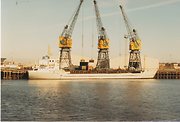 Created by Francis Elsdon
Donated by Hartlepool Museum Service
Created by Francis Elsdon
Donated by Hartlepool Museum ServicePart of the Elsdon Collection collection
Dated 1987
MV Vanessa at berth in the Deep Water Berth, Hartlepool.
More detail » MV Vera 1
MV Vera 1
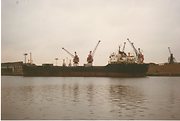 Created by Francis Elsdon
Donated by Hartlepool Museum Service
Created by Francis Elsdon
Donated by Hartlepool Museum ServicePart of the Elsdon Collection collection
Dated 1988
MV Vera 1 in the Jackson Dock, Hartlepool. Used to be called Fort Point.
More detail » MV Verona
MV Verona
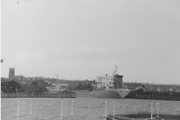 Created by Francis Elsdon
Donated by Hartlepool Museum Service
Created by Francis Elsdon
Donated by Hartlepool Museum ServicePart of the Elsdon Collection collection
Dated 1987
MV Verona in the Union Dock, Hartlepool.
More detail » MV Viking Bank
MV Viking Bank
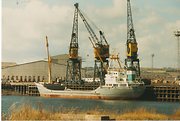 Created by Francis Elsdon
Donated by Hartlepool Museum Service
Created by Francis Elsdon
Donated by Hartlepool Museum ServicePart of the Elsdon Collection collection
Dated 1987
MV Viking Bank at berth in the North Basin.
More detail » MV Volga 4001 (Russian)
MV Volga 4001 (Russian)
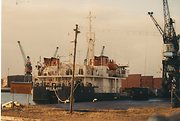 Created by Francis Elsdon
Donated by Hartlepool Museum Service
Created by Francis Elsdon
Donated by Hartlepool Museum ServicePart of the Elsdon Collection collection
Dated 1988
MV Volga 4001 (Russian) at berth in the Union Dock, Hartlepool.
More detail » MV Yorkshire Lady
MV Yorkshire Lady
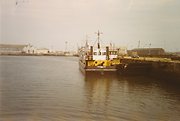 Created by Francis Elsdon
Donated by Hartlepool Museum Service
Created by Francis Elsdon
Donated by Hartlepool Museum ServicePart of the Elsdon Collection collection
Dated 1959
MV Yorkshire Lady in Irvine Quay, Hartlepool
More detail » MV Zgorzelec
MV Zgorzelec
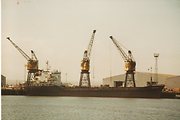 Created by Francis Elsdon
Donated by Hartlepool Museum Service
Created by Francis Elsdon
Donated by Hartlepool Museum ServicePart of the Elsdon Collection collection
Dated 1985
MV Zgorzelec in the Deep Water Berth, Hartlepool
More detail » Middleton
Middleton
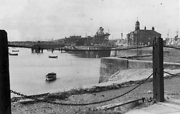 Created by Bill Boagey
Donated by Hartlepool Museum Service
Created by Bill Boagey
Donated by Hartlepool Museum ServicePart of the Bill Boagey collection
Middleton area. The Custom House can be seen. This was to become the home of Hartlepool Divers and the Sea Cadets for a while. Now part of the Marina. Coal Staithes can be seen as well.
More detail » Middleton coal staithes
Middleton coal staithes
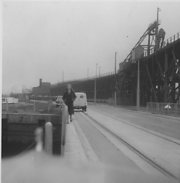 Created by Bill Boagey
Donated by Hartlepool Museum Service
Created by Bill Boagey
Donated by Hartlepool Museum ServicePart of the Bill Boagey collection
Middleton coal staithes. Used for loading coal into ships. Removed during redevelopment of the Docks.
More detail » Mould Loft CMEW
Mould Loft CMEW
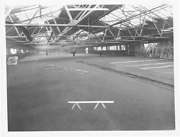 Part of the Hartlepool Library Services collection
Part of the Hartlepool Library Services collectionThe Mould Loft at CMEW works
More detail » National Coal Board (NCB) drilling rig
National Coal Board (NCB) drilling rig
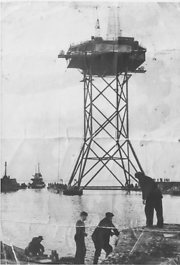 Donated by Hartlepool Museum Service
Donated by Hartlepool Museum ServiceDated 1958
Old N.C.B. drilling platform being floated out of Hartlepool Docks. The rig was first floated on July 21st 1958 and on August 2nd left Hartlepool to take up position at Blackhall having been delayed a number of times because of poor weather and sea conditions.
Local resident Chris Martin remembers:"I am now 56 but was a young lad in the 60s. From 1964 to about 1971, my father had a sailing boat moored on one of the old swinging mud moorings at West Hartlepool Sailing Club. I have vivid memories of a rig similar to the one shown in this photograph, being moored up alongside the harbour wall in what was known as the outer harbour. Why, I hear you ask would such a thing stick in a kids mind? Bonfire night. The men on the rig lowered down a large wicker basket of assorted pies (and subsequently gained access to the club facilities)".
More detail » New plating shed
New plating shed
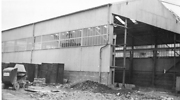 Donated by Hartlepool Museum Service
Donated by Hartlepool Museum ServiceNew plating shed. Location not known, possibly Graythorp.
More detail » New sheds
New sheds
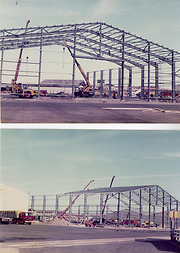 Created by Francis Elsdon
Donated by Hartlepool Museum Service
Created by Francis Elsdon
Donated by Hartlepool Museum ServicePart of the Elsdon Collection collection
Dated 1982
New sheds being built adjacent to the Deep Water Berth, Hartlepool in 1982.
More detail » No.3 Dock Gates
No.3 Dock Gates
 Created by L. Brittain
Donated by Les Hawksfield
Created by L. Brittain
Donated by Les HawksfieldBuilding work being carried out on the No.3 docks gates between Central Dock and the North Basin. The No.8 Warehouse and the 80-ton sheer legs can be seen in the background. Date unknown.
More detail » North Basin on Docks
North Basin on Docks
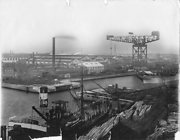 Donated by Hartlepool Museum Service
Donated by Hartlepool Museum ServiceNorth Basin on Docks with the CMEW hammerhead crane at the fitting out berth. Ship to right hand of picture is the MV Portscatho. Another ship discharging timber in the foreground.
More detail » North Pier breach
North Pier breach
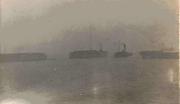 Created by unknown
Donated by Les Hawksfield
Created by unknown
Donated by Les HawksfieldDated 1913
Damage to the North Pier after a major storm in January 1913.
More detail » North Swing Bridge
North Swing Bridge
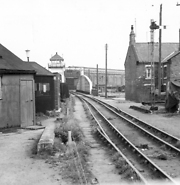 Donated by Hartlepool Museum Service
Donated by Hartlepool Museum ServicePart of the Shipbuilding collection
Dated 1962
North Swing Bridge looking from CMEW across the North Basin to Richardsons. Swing bridge was dual use. Rail Traffic on one side, road on the other.
More detail » Offloading wood pulp at the Union Dock
Offloading wood pulp at the Union Dock
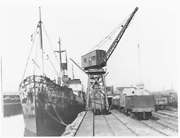 Donated by Douglas Ferriday
Donated by Douglas FerridayPart of the Hartlepool Library Service collection
An undated photograph of the Finnish steamship Waija offloading her cargo at Union Dock. Built in 1912, she was eventually broken-up in 1961. picture c1950
HHT&N 815
More detail » Oil Rig Re-cycling
Oil Rig Re-cycling
THC Fabricators Construction Shed, Greenland Road Site, Hartlepool Docks, re-cycling redundant Oil Rig Support Legs.
More detail » On the Dockside
On the Dockside
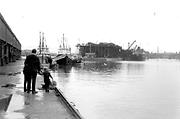 Created by unknown
Donated by Mr. John Robinson
Created by unknown
Donated by Mr. John RobinsonJohn Robinson with his son Paul and daughter Sarah, on the docks in 1970.
More detail » On the Fish Quay
On the Fish Quay
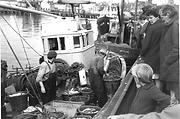 Created by unknown
Donated by Mr. John Robinson
Created by unknown
Donated by Mr. John RobinsonDated 1970
Young Sarah Robinson checks a local fishing boat's catch in 1970.
More detail » Paddle tug heading out from Middleton
Paddle tug heading out from Middleton
 Created by unknown
Donated by Hartlepool Library Service
Created by unknown
Donated by Hartlepool Library ServiceAn unknown paddle tug passing through West Harbour and heading out to sea with the Coal Dock gate in the foreground.
HHT&N 584
More detail » Painting from 1847
Painting from 1847
 Donated by Hartlepool Library Service
Donated by Hartlepool Library ServiceCopy of sun painting, 1847. View looking south from the West Dock entrance. Windmills ? Newburn area? In distance Seaton Windmill.
HHT&N 821
More detail » Picture of ships in dock at Hartlepool
Picture of ships in dock at Hartlepool
 Donated by Hartlepool Library Service
Donated by Hartlepool Library ServicePicture of ships in dock at Hartlepool. It looks like swainson dock on the right.
HHT&N 336
More detail » Pilot Cutter 'Crofter'
Pilot Cutter 'Crofter'
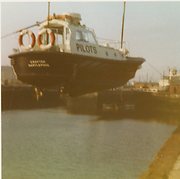 Created by Francis Elsdon
Donated by Hartlepool Museum Service
Created by Francis Elsdon
Donated by Hartlepool Museum ServicePart of the Elsdon Collection collection
Dated 1975
Pilot Cutter 'Crofter' undergoing maintenance.
More detail » Pipes on the Docks (1)
Pipes on the Docks (1)

Two workmen alongside some old pipes on the docks. It looks like the pipes are being cut up. Taken in July 1973
HHT&N 451
More detail » Pipes on the Docks (3)
Pipes on the Docks (3)
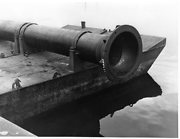 Donated by Hartlepool Library Service
Donated by Hartlepool Library ServiceA pipe the same as those in the previous pictures still attached to a barge. Taken in July 1973
HHT&N 450
More detail » Pit Props at Union Dock Hartlepool
Pit Props at Union Dock Hartlepool
 Donated by Mike Oxley
Donated by Mike OxleyPit props brought in to Union Dock, Hartlepool taken from a postcard from around 100 years ago.
More detail » Pit Props being unloaded
Pit Props being unloaded
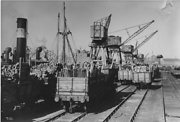 Donated by Hartlepool Museum Service
Donated by Hartlepool Museum ServicePart of the David Wise collection
Pit props being unloaded by cranes onto wagons at the Docks. This is one of a series of photos that was salvaged by Mr Andrews from the Railway Office on the Docks.
More detail » Pit props on dockside
Pit props on dockside
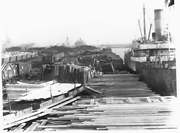 Donated by Douglas Ferriday
Donated by Douglas FerridayPart of the Hartlepool Library Service collection
Pit props on dockside, presumably from the ship moored alongside
More detail » Platers Shed
Platers Shed
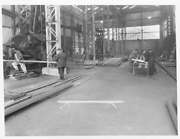 Part of the Hartlepool Library Services collection
Part of the Hartlepool Library Services collectionThe Platers' Shed at CMEW.
More detail » Port & Harbour Office 1967
Port & Harbour Office 1967
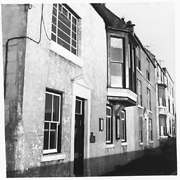 Donated by Douglas Ferriday
Donated by Douglas FerridayPart of the Hartlepool Library Service collection
This picture is marked as Port & Harbour Office 1967 though no location is given. It looks like one of the terraced streets on the Headland.
More detail » Port Authorities
Port Authorities
Images and information relating to the people and vessels of the local (Tees & Hartlepool) Port Authorities.
More detail » Post card of hauled out fishing boats
Post card of hauled out fishing boats
 Donated by Hartlepool Museum Service
Donated by Hartlepool Museum ServicePart of the Fishing collection
Post card of hauled out fishing boats, 'Ivy of Leith' and 'The Michelle'
More detail » Reconstruction of Staiths
Reconstruction of Staiths
 Created by N.E.R. District Dock Engineer
Donated by Hartlepool Museum Service
Created by N.E.R. District Dock Engineer
Donated by Hartlepool Museum ServiceDated 1931
Looking east to the reconstruction of Harbour Terrace staiths
More detail » Riveters on SS Ramses
Riveters on SS Ramses
 Donated by Douglas Ferriday
Donated by Douglas FerridayPart of the Hartlepool Library Services collection
Riveters on SS Ramses c1950
More detail » Roll on, roll off berth
Roll on, roll off berth
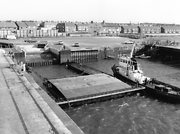 Donated by Hartlepool Library Service
Donated by Hartlepool Library ServiceSeems to be the construction of the roll on, roll off berth at Hartlepool Deep Water Berth.
HHT&N 306
More detail » SV Regina Caelis
SV Regina Caelis
 Created by Francis Elsdon
Donated by Hartlepool Museum Service
Created by Francis Elsdon
Donated by Hartlepool Museum ServicePart of the Elsdon Collection collection
Dated 1986
SV Regina Caelis, a three masted sailing ship, on the Ballast Quay, Hartlepool.
More detail » Sailing Yachts in Middleton Harbour
Sailing Yachts in Middleton Harbour
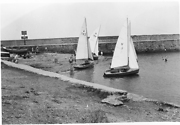 Created by Bill Boagey
Donated by Hartlepool Museum Service
Created by Bill Boagey
Donated by Hartlepool Museum ServicePart of the Bill Boagey collection
Sailing Yachts in Middleton Harbour. Also people swimming.
More detail » Sailing in Union Dock
Sailing in Union Dock
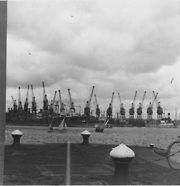 Created by Bill Boagey
Donated by Hartlepool Museum Service
Created by Bill Boagey
Donated by Hartlepool Museum ServicePart of the Bill Boagey collection
Sail Boats in Union Dock with numerous cranes in the background.
More detail » Sailing ship coming into port
Sailing ship coming into port
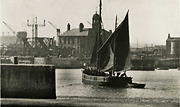 Donated by Hartlepool Library Service
Donated by Hartlepool Library ServiceSailing ship coming into port at Hartlepool.
More detail » Sailing ships at berth
Sailing ships at berth
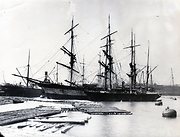 Donated by Hartlepool Library Service
Donated by Hartlepool Library ServiceSailing ships at berth at Hartlepool Docks. Ship in the background unloading timber.
HHT&N 286
More detail » Sailing ships in the docks
Sailing ships in the docks
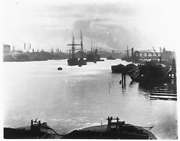 Donated by Douglas Ferriday
Donated by Douglas FerridayPart of the Hartlepool Library Services collection
Dated 1920
Sailing ships in Hartlepool Docks circa 1920.
More detail » Sheds at Shipyard
Sheds at Shipyard
 Donated by Hartlepool Museum Service
Donated by Hartlepool Museum ServiceSheds at Shipyard. possibly Graythorp.
More detail » Ship Construction
Ship Construction
 Donated by Hartlepool Museum Service
Donated by Hartlepool Museum ServiceEarly stage of ship construction. Erecting the stern frame.
More detail » Ship Construction
Ship Construction
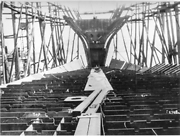 Donated by Hartlepool Museum Service
Donated by Hartlepool Museum ServiceEarly stage of ship construction. Ship on stocks. Looking aft towards stern frame.
More detail » Ship in North Basin receiving her new boiler
Ship in North Basin receiving her new boiler
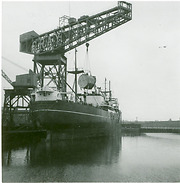 Donated by Hartlepool Museum Service
Donated by Hartlepool Museum ServiceShip in North Basin receiving her new boiler. It is being deliverd by the CMEW Crane.
More detail » Ship under construction
Ship under construction
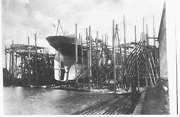 Part of the Hartlepool Library Services collection
Part of the Hartlepool Library Services collectionShip under construction at unknown works.
More detail » Ships in Victoria Dock Hartlepool
Ships in Victoria Dock Hartlepool
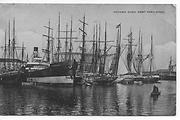 Donated by Mike Oxley
Donated by Mike OxleyShips in Victoria Dock, Hartlepool taken from a postcard aged around 100 years.
More detail » Signal Mast Demolished
Signal Mast Demolished
 Created by LNER
Donated by Hartlepool Museum Service
Created by LNER
Donated by Hartlepool Museum ServiceDated 1935
The 40 foot signal standard outside the pilot's office was struck by the steamer Silver Pine which became out of control in a high wind when she was being assisted into port by two tugs. The tugs collided & one was driven ashore whilst the other lost her propeller. The steamer was on her way from Sunderland to R. Westgarth to be re-engined.
More detail » Skeleton Pier
Skeleton Pier
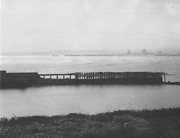 Donated by Hartlepool Museum Service
Donated by Hartlepool Museum ServiceSkeleton Pier on the docks. Steelworks in background. This area became part of Hartlepool Marina
More detail » Small craft in Victoria Dock
Small craft in Victoria Dock
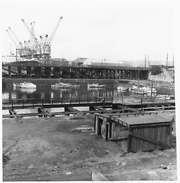 Donated by Douglas Ferriday
Donated by Douglas FerridayPart of the Hartlepool Library Services collection
Dated 1972
Small craft and fishing boats are moored in the deep water berth at Victoria Dock, June 1972.
More detail » St Jernvik unloading timber
St Jernvik unloading timber
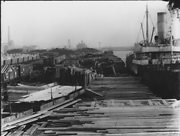 Donated by Hartlepool Museum Service
Donated by Hartlepool Museum ServiceSt Jernvik in Jackson Dock. The Dock Master's Office is in the centre distance. The ship was built in 1883 as Balbus, renamed Louise in 1892 & St Jernvik in 1918 by her Swedish owners. She was lost in a collision in 1928.
HHT+N 751
More detail » Staflo Rig
Staflo Rig
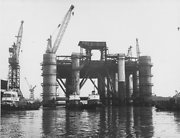 Donated by Hartlepool Museum Service
Donated by Hartlepool Museum ServiceStaflo Rig being towed by 4 tugs from Hartlepool docks.
More detail » Steam Engine 68703
Steam Engine 68703
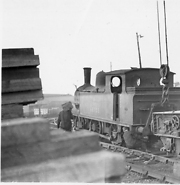 Donated by Hartlepool Museum Service
Donated by Hartlepool Museum ServicePart of the Shipbuilding collection
Dated 1955
Tank Engine 68703 on the docks. It appears that the loco has derailed and that the workers are about to re-rail it. On the extreme right is part of the rail mounted breakdown crane and a spreader bar has been attached under the rear buffers of the engine to lift the rear of the engine back onto the track.
More detail » Steam locomotive watering tower
Steam locomotive watering tower
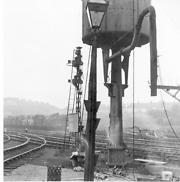 Donated by Hartlepool Museum Service
Donated by Hartlepool Museum ServicePart of the Shipbuilding collection
Dated 1964
Steam locomotive watering tower on the docks. Wagons containg pit props behind. Note the gas lamp. The Queens Rink Ballroom can just be made out on the left.
More detail » Steamship being fitted out
Steamship being fitted out
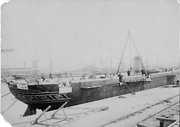 Donated by Hartlepool Museum Service
Donated by Hartlepool Museum ServiceSteamship being fitted out in the mis to late 19th century. Three masted sailing ship in the background. The steamer appears to have a wooden hull. A few workmen about.
More detail » Stjernvik off-loading timber
Stjernvik off-loading timber
 Created by unknown
Donated by Hartlepool Library Service
Created by unknown
Donated by Hartlepool Library ServiceThe Swedish steamship Stjernvik off-loading at the timber wharf, sometime between 1918-1928.
More detail » Swan Neck Crane
Swan Neck Crane
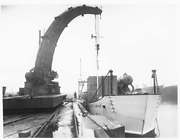 Donated by Douglas Ferriday
Donated by Douglas FerridayPart of the Hartlepool Library Services collection
The Motor Vessel Lady Jane alongside the Swan Neck Crane. Date unknown.
More detail » Swan Neck Crane
Swan Neck Crane
 Donated by Hartlepool Library Service
Donated by Hartlepool Library ServiceSwan Neck Crane in the Old Harbour (now part of Victoria Dock) during the 1970s. The old docks footbridge in the background.
More detail » Swing Bridge
Swing Bridge
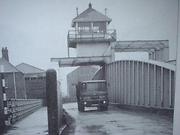 Donated by Hartlepool Library Service
Donated by Hartlepool Library ServiceLorry crossing the swing bridge, Middleton Road, on the docks.
More detail » T.C.C. 23
T.C.C. 23
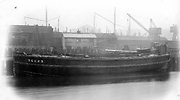 Created by unknown
Donated by Hartlepool Library Service
Created by unknown
Donated by Hartlepool Library ServicePart of the Hartlepool Library Services collection
The Tees Conservancy Commissioner's steam barge T.C.C. 23, berthed at the quay in Swainson Dock.
More detail » Taklift
Taklift
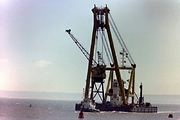 Created by Mr. John Brooker
Donated by Mr. John Brooker
Created by Mr. John Brooker
Donated by Mr. John BrookerThe barge crane Taklift entering Hartlepool Port Channel from Tees Dock carrying a dockside crane. This crane's jib can be seen sticking out to left.
More detail » The Base of the Swan Neck Crane
The Base of the Swan Neck Crane
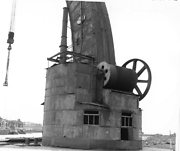 Donated by Hartlepool Library Service
Donated by Hartlepool Library ServiceThe Base of the Swan Neck Crane in a state of dereliction.
More detail » The City of Dieppe
The City of Dieppe
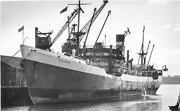 Donated by Hartlepool Museum Service
Donated by Hartlepool Museum ServiceThe City of Dieppe at berth in Hartlepool. William Gray's 1000th ship.
More detail » The Docks Hartlepool
The Docks Hartlepool
 Donated by Mike Oxley
Donated by Mike OxleyThe Docks, Hartlepool taken from a postcard around 100 years old.
More detail » The Docks Hartlepool
The Docks Hartlepool
 Donated by Mike Oxley
Donated by Mike OxleyThe Docks, Hartlepool taken from a postcard around 100 years old.
More detail » The Docks about 1964
The Docks about 1964
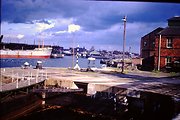 Created by Doris Wilson
Donated by the family of the late Doris Wilson
Created by Doris Wilson
Donated by the family of the late Doris WilsonDated 1964
On the left of the photograph would be the deep water berth. The coal staiths which can be seen in the background are those betwen Victoria Dock and the Old Harbour. Right in the centre of the image are the tugs Stranton and Hart and behind them is the fish quay. The building on the right is the Customs Watch House and the swing bridge would be on the right. The shadow of the mesh on the bridge is actually visible.
The ship on the right is an ore carrier.
In the background, St Hilda's Church, the Borough Hall and the tower of St Mary's can be seen.
More detail » The Swan Neck Crane
The Swan Neck Crane
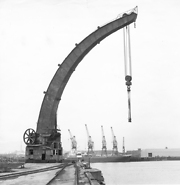 Donated by Hartlepool Museum Service
Donated by Hartlepool Museum ServiceThe Swan Neck Crane. Ship Scol Unit in background
More detail » The Swan Neck Crane
The Swan Neck Crane
 Donated by Hartlepool Museum Service
Donated by Hartlepool Museum ServiceThe Swan Neck Crane on Irivine's Quay Middleton Shipyard, West Hartlepool.
Details of the Gearing and Clutch mechanism.
More detail » The Swan Neck Crane
The Swan Neck Crane
 Donated by Hartlepool Museum Service
Donated by Hartlepool Museum ServiceThe Swan Neck Crane on Irivine's Quay Middleton Shipyard, West Hartlepool.
Bottom part of the boiler showing the furnace door. The Crane was steam driven.
More detail » The Swan Neck Crane
The Swan Neck Crane
 Donated by Hartlepool Museum Service
Donated by Hartlepool Museum ServiceThe Swan Neck Crane at Irvines Quay, Middleton Shipyard. Detail of gearing. The shaft rod running from top to bottom of the picture probably operates a type of clutch to engage or disengage the gear wheels.
More detail » The Swan Neck Crane
The Swan Neck Crane
 Donated by Hartlepool Museum Service
Donated by Hartlepool Museum ServiceThe Swan Neck Crane at Irvines Quay, Middleton Shipyard. Detail of gearing. Detail of the gearing used to drive the winding gear.
More detail » The Swan Neck Crane
The Swan Neck Crane
 Donated by Hartlepool Museum Service
Donated by Hartlepool Museum Service
The Swan Neck Crane at Irvines Quay, Middleton Shipyard. Crane manufacturers name plate. Cowans, Sheldon & Co. Ltd.
hht&n 1080
More detail » The Swan Neck Crane
The Swan Neck Crane
 Donated by Hartlepool Museum Service
Donated by Hartlepool Museum ServiceThe Swan Neck Crane at Irvines Quay, Middleton Shipyard. Detail of gearing. Detail of the gearing used to drive the winding gear.
More detail » The Swan Neck Crane
The Swan Neck Crane
 Donated by Hartlepool Museum Service
Donated by Hartlepool Museum ServiceThe Swan Neck Crane at Irvines Quay, Middleton Shipyard. Rear view of the crane.
More detail » The Swan Neck Crane
The Swan Neck Crane
 Donated by Hartlepool Museum Service
Donated by Hartlepool Museum ServiceThe Swan Neck Crane at Irvines Quay, Middleton Shipyard. External view of the cabin with broken windows.
More detail » The Swan Neck Crane
The Swan Neck Crane
 Donated by Hartlepool Museum Service
Donated by Hartlepool Museum ServiceThe Swan Neck Crane at Irvines Quay, Middleton Shipyard. Detail of the gearing which drove rope drum.
More detail » The Swan Neck Crane
The Swan Neck Crane
 Donated by Hartlepool Museum Service
Donated by Hartlepool Museum ServiceThe Swan Neck Crane at Irvines Quay, Middleton Shipyard. Another view of the cabin and some of the winding gear.
More detail » The Swan Neck Crane
The Swan Neck Crane
 Donated by Hartlepool Museum Service
Donated by Hartlepool Museum ServiceThe Swan Neck Crane, Irvine's Quay, Middleton Shipyard. Detail of the controls in the cab.
hht&n 1081
More detail » The Swan Neck Crane
The Swan Neck Crane
 Donated by Hartlepool Museum Service
Donated by Hartlepool Museum ServiceThe Swan Neck Crane, Irvine's Quay, Middleton Shipyard. The 'Neck'
More detail » The Swan Neck Crane
The Swan Neck Crane
 Donated by Hartlepool Museum Service
Donated by Hartlepool Museum ServiceThe Swan Neck Crane, Irvine's Quay, Middleton Shipyard. Showing parts of the winding mechanism.
More detail » The Swan Neck Crane
The Swan Neck Crane
 Donated by Hartlepool Museum Service
Donated by Hartlepool Museum ServiceThe Swan Neck Crane, Irvine's Quay, Middleton Shipyard. Showing the whole structure.
More detail » The Swan Neck Crane
The Swan Neck Crane
 Donated by Hartlepool Museum Service
Donated by Hartlepool Museum ServiceThe Swan Neck Crane, Irvine's Quay, Middleton Shipyard. Showing a side view.
HHT&N 826
More detail » The Swan Neck Crane
The Swan Neck Crane
 Donated by Hartlepool Museum Service
Donated by Hartlepool Museum ServiceThe Swan Neck Crane, Irvine's Quay, Middleton Shipyard. Showing a side view.
More detail » The Swan Neck Crane
The Swan Neck Crane
 Donated by Hartlepool Museum Service
Donated by Hartlepool Museum ServiceThe Swan Neck Crane, Irvine's Quay, Middleton Shipyard. Showing the quayside.
More detail » The Swan Neck Crane
The Swan Neck Crane
 Donated by Hartlepool Museum Service
Donated by Hartlepool Museum ServiceThe Swan Neck Crane on a derelict wharf.
More detail » The Swan Neck Crane
The Swan Neck Crane
 Donated by Hartlepool Museum Service
Donated by Hartlepool Museum ServiceThe Swan Neck Crane during it's final days.
More detail » The Swan Neck Crane
The Swan Neck Crane
 Donated by Hartlepool Museum Service
Donated by Hartlepool Museum ServiceThe Swan Neck Crane, details of the neck.
More detail » The Swan Neck Crane
The Swan Neck Crane
 Donated by Hartlepool Museum Service
Donated by Hartlepool Museum ServiceThe controls of the Swan Neck Crane.
More detail » The Swan Neck Crane
The Swan Neck Crane
 Donated by Hartlepool Museum Service
Donated by Hartlepool Museum ServiceSwan Neck Crane cylinder and crank.
More detail » The remarkable affair at West Hartlepool Docks
The remarkable affair at West Hartlepool Docks
A ship got stuck going through the lock gates
On Tuesday 9th May, 1876, at ten minutes to four in the morning, a Norwegian ship called the Europa, tried to pass through West Hartlepool dock gates. She was heading towards Jackson Dock, but got stuck when half-way through.
The accident happened at high tide, when the deep water made it easiest for ships to come in and go out of the dock. When the Europa got stuck, the lock gates could not be closed to shut in the water, as they usually did. The tide would soon go out, and the water would run out of the dock.
The Europa was a Norwegian ship, from Sandjefjord, laden with timber. A powerful paddle steam tug, Conqueror, tried to haul Europa free. This did not work. Three more tugs joined the Conqueror, and they all tried in vain to tow her clear. As the tide was going out the ship had to stay where she was until the next high tide.
The worst that could have happened
If the worst had happened, there could have been two disasters. The first would be that all the ships in the dock would fall over sideways, because there wasn’t any water to hold them up. This would damage both themselves and any ship they fell onto. The second was that the sides of the dock could have caved in when the pressure of the water was not there to hold them out. This could have brought down the enormous warehouses built on the quayside.
Rumours brought a big crowd
Meanwhile, word had got around amongst the shipping community and the townspeople. The docks were rapidly emptying of water, it was said. The warehouses might come down, without the pressure of the water to hold up the dock walls.
Thousands of people flocked to the scene of the accident almost as soon as it had happened. Some of them may have realised what a disaster it could have been, but many probably came out of curiosity.
What did happen
Happily, the tide went down slowly enough, over about six hours, so that people working in the dock could prevent the ships’ damaging each other. They moved them further apart, to lessen the damage.
The sides of the dock did not fall in, so workmen at the dock took the opportunity to do some running repairs below the normal level of the water.
The dock officials did their best to avoid any accidents, but they could not prevent all of the damage. They shut the gates of the Swainson Dock, which protected the warehouses around that dock. The timber docks were also made safe.
But none of the other dock-gates could be closed. Those leading into the Coal Dock from Jackson Dock were hung so that the weight of water in the Coal Dock would have pushed them open. Hence all the vessels moored in these docks were left in a depth of about a metre of water. There were lots of ships in the dock and most of them fell over on their sides.
Although the dock officials put the ships further apart, there was some damage. About forty of the ships, which were made of wood, had their planks pulled apart as well as other damage. The ship Philo, was crushed by Her Majesty’s training ship Trincomalee, which lay next to her. The crew of the Trincomalee did their best to keep their ship in as upright a position as they could by means of mooring chains and ropes attached to mooring posts on the quayside.
Some of deck cargo was taken off Europa and she floated on the next tide. This was on Tuesday afternoon between three and four o’ clock. She was quite a heavy ship for the time, but being protected with copper underneath, escaped with relatively little damage.
The aftermath
The ship owners could have made claims against the Dock Company, for the damage to their ships. There were not as many claims made as the Dock Company feared. Those that did claim were mostly foreign owners, excepting Mr Isaac Bedlington of West Hartlepool, whose ship, the Deodar, was severely damaged. The Norwegian ship, the Familiar, was also very shaken up.
More detail » Timber Pond
Timber Pond
 Donated by Hartlepool Library Service
Donated by Hartlepool Library ServiceTmber Pond, East Side, West Hartlepool. Ship being constructed in the background and steam driven cranes.
HHT&N807
More detail »
 Timber Quay collapse (1)
Timber Quay collapse (1)
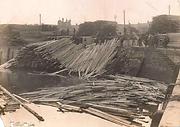 Created by L. Brittain
Donated by Les Hawksfield
Created by L. Brittain
Donated by Les HawksfieldThe collapsed portion the timber quay, which apparently gave way due to the weight of timber stacked on the edge. This might be the 'Pyman Quay, in the Swainson/Hart Dock. The buildings of Church Street can be seen in the background. Date unknown.
More detail » Timber Quay collapse (2)
Timber Quay collapse (2)
 Created by L. Brittain
Donated by Les Hawksfield
Created by L. Brittain
Donated by Les HawksfieldClose-up of damage to the timber quay, with the offices of R.Wade & Sons, Timber Importers, in the background. This might be the 'Pyman Quay, in the Swainson/Hart Dock.
Wade and Sons first appear in the Kelly's Trade Directory of 1885, with premises at Commercial Terrace. In the 1938 Directory they are listed at Central Buildings, Church Street.
In 1906 they are listed as timber and telegraph pole merchants.
 Trawler in Old Harbour
Trawler in Old Harbour
 Donated by Hartlepool Museum Service
Donated by Hartlepool Museum ServiceA Grimsby trawler being reboilerd using the swan neck crane at Irvine's Quay.
HHT&N 790
More detail » Trawlers in Old Harbour
Trawlers in Old Harbour
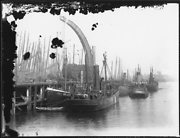 Donated by Hartlepool Museum Service
Donated by Hartlepool Museum ServiceThe trawler Elsie being reboilerd using the swan neck crane at Irvine's Quay. Other trawler visible is the Dragon from Middlesbrough.
More detail » Tug 'Sandex'
Tug 'Sandex'
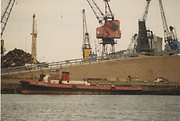 Created by Francis Elsdon
Donated by Hartlepool Museum Service
Created by Francis Elsdon
Donated by Hartlepool Museum ServicePart of the Elsdon Collection collection
Tug 'Sandex' in Union Dock, Hartlepool.
More detail » Union Dock Hartlepool
Union Dock Hartlepool
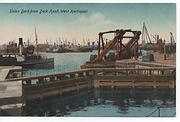 Donated by Mike Oxley
Donated by Mike OxleyUnion Dock Hartlepool taken from a postcard around 100 years old.
More detail » Unknown East German Vessel
Unknown East German Vessel
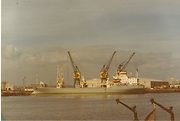 Created by Francis Elsdon
Donated by Hartlepool Museum Service
Created by Francis Elsdon
Donated by Hartlepool Museum ServicePart of the Elsdon Collection collection
Unknown East German Vessel at berth in the Deep Water Berth.
More detail » Unknown ship at the Swan Neck Crane
Unknown ship at the Swan Neck Crane
 Created by unknown
Donated by Lynn Gowland
Created by unknown
Donated by Lynn GowlandDated 1931
An unknown ship lying alongside at the Swan Neck Crane, on July 19th, 1931.
More detail » Unknown shipyard
Unknown shipyard
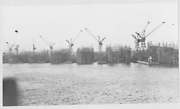 Part of the Hartlepool Library Services collection
Part of the Hartlepool Library Services collectionEarly picture of unknown shipyard. Using wood as scaffolding.
More detail » Unloading Vauxhall Novas
Unloading Vauxhall Novas
 Donated by Hartlepool Library Service
Donated by Hartlepool Library ServiceAn auto liner with a Vauxhall Nova being driven off. There was a time in the seventies when a lot of new Vauxhall cars came into Hartlepool.
HHT&N 279
More detail » Unloading pit props
Unloading pit props
 Donated by Hartlepool Library Service
Donated by Hartlepool Library ServiceUnloading pit props straight in to rolling stock. a steam train in the picture.
HHT&N 318
More detail » Unloading pit props from a ship at the docks
Unloading pit props from a ship at the docks
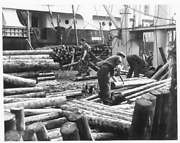 Donated by Douglas Ferriday
Donated by Douglas FerridayPart of the Hartlepool Library Services collection
Dated 1964
Dock workers use hooks and ropes to unload pit props at Hartlepool docks in 1964.
More detail » Unloading pit props into rolling stock
Unloading pit props into rolling stock
 Part of the Hartlepool Library Services collection
Part of the Hartlepool Library Services collectionPit props being unloaded into rolling stock at Hartlepool docks.
More detail » Unloading timber
Unloading timber
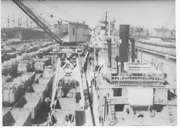 Part of the Hartlepool Library Services collection
Part of the Hartlepool Library Services collectionUnloading timber at 'A' jetty, Union Dock.
More detail » Unloading timber at Jackson Dock
Unloading timber at Jackson Dock
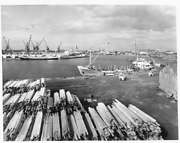 Donated by Douglas Ferriday
Donated by Douglas FerridayPart of the Hartlepool Library Services collection
Dated 1968
Jackson Dock in 1968. In the foreground the ship Roelof Jan is unloading her cargo of timber.
More detail » Unloading timber on the docks
Unloading timber on the docks
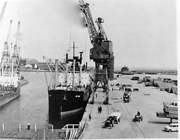 Donated by Hartlepool Library Service
Donated by Hartlepool Library ServiceA crane unloading timber from a ship on the docks. Timber being ferried by tractors.
HHT&N 326
More detail » View across the Coal Dock
View across the Coal Dock
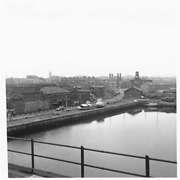 Donated by Douglas Ferriday
Donated by Douglas FerridayPart of the Hartlepool Library Services collection
Dated 1966
Elevated view across the Coal Dock taken circa 1966. The Dock Office with it's distinctive clock tower can be seen on the right along with the tall chimneys of the neighbouring Custom House. The spire of Christ Church can be seen in the distance.
More detail » View from the Coal Staithes
View from the Coal Staithes
 Donated by Hartlepool Library Service
Donated by Hartlepool Library ServiceA view from the top of the coal staithes over the coal dock. The Custom House can be seen as well as Christ Church spire.
HHT+N 707
More detail » View of Hartlepool Docks
View of Hartlepool Docks
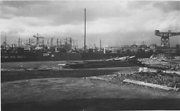 Donated by Hartlepool Museum Service
Donated by Hartlepool Museum ServiceView of Hartlepool Docks with CMEW crane on the right.
More detail » View of the Fish Quay area
View of the Fish Quay area
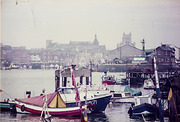 Created by Francis Elsdon
Donated by Hartlepool Museum Service
Created by Francis Elsdon
Donated by Hartlepool Museum ServicePart of the Elsdon Collection collection
Dated 1982
View of the Fish Quay area. St Hilda's Church in the background.
More detail » Warehouses and the Swan Neck Crane
Warehouses and the Swan Neck Crane
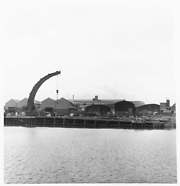 Donated by Douglas Ferriday
Donated by Douglas FerridayPart of the Hartlepool Library Services collection
Dated 1972
A view of the warehouses and the swan neck crane in the Old Harbour, 1972, taken from the coal staithes side of Victoria Dock.
More detail » West Harbour (1)
West Harbour (1)
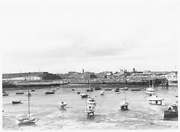 Created by Elizabeth Law
Donated by Elizabeth Law
Created by Elizabeth Law
Donated by Elizabeth LawPart of the Hartlepool Library Service collection
Dated 1970
Small pleasure craft in the West Harbour at low tide, circa 1970. In the background can be seen Christ Church (centre), with the Municpal Buildings to the left and various Dock Offices to the right.
More detail » West Harbour (2)
West Harbour (2)
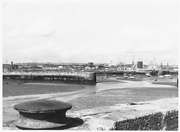 Created by Elizabeth Law
Donated by Elizabeth Law
Created by Elizabeth Law
Donated by Elizabeth LawPart of the Hartlepool Library Service collection
Dated 1970
Panoramic view across West Harbour looking towards Middleton, circa 1970.
More detail » Women in the shipyards
Women in the shipyards
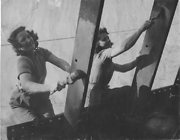 Donated by Hartlepool Museum Service
Donated by Hartlepool Museum ServiceTwo women painting a ship in the Shipyards during WW2.
More detail » Women in the shipyards
Women in the shipyards
 Donated by Hartlepool Museum Service
Donated by Hartlepool Museum ServiceWomen in the shipyards just finishing their shift during WW2.
More detail » Women shipbuilders descending the gangway
Women shipbuilders descending the gangway
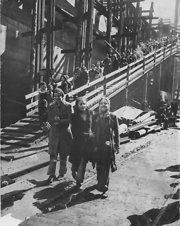 Donated by Hartlepool Museum Service
Donated by Hartlepool Museum ServiceWomen shipbuilders descending the gangway during WW2. It could be lunchtime or the end of their shift.
More detail » Zeehond, Dutch submarine
Zeehond, Dutch submarine
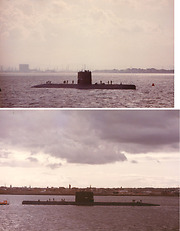 Created by Francis Elsdon
Donated by Hartlepool Museum Service
Created by Francis Elsdon
Donated by Hartlepool Museum ServicePart of the Elsdon Collection collection
Dated 1981
Zeehond, Dutch submarine entering Hartlepool.
More detail »




